Understanding the Dynamics of Marketing
VerifiedAdded on 2019/12/04
|19
|6252
|294
Essay
AI Summary
Tactical Tool for Marketing Intelligence and Planning
Contribute Materials
Your contribution can guide someone’s learning journey. Share your
documents today.
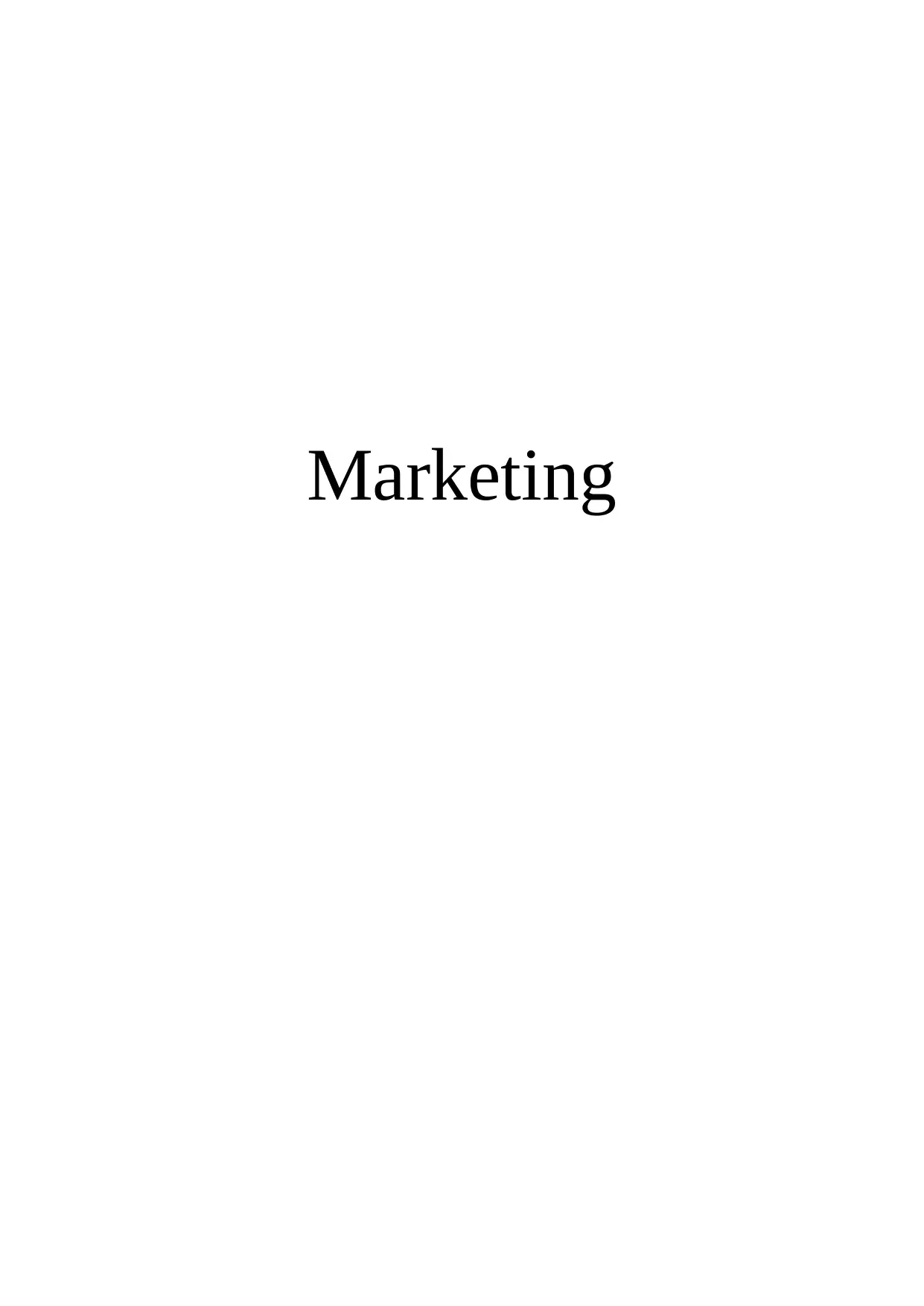
Marketing
Secure Best Marks with AI Grader
Need help grading? Try our AI Grader for instant feedback on your assignments.
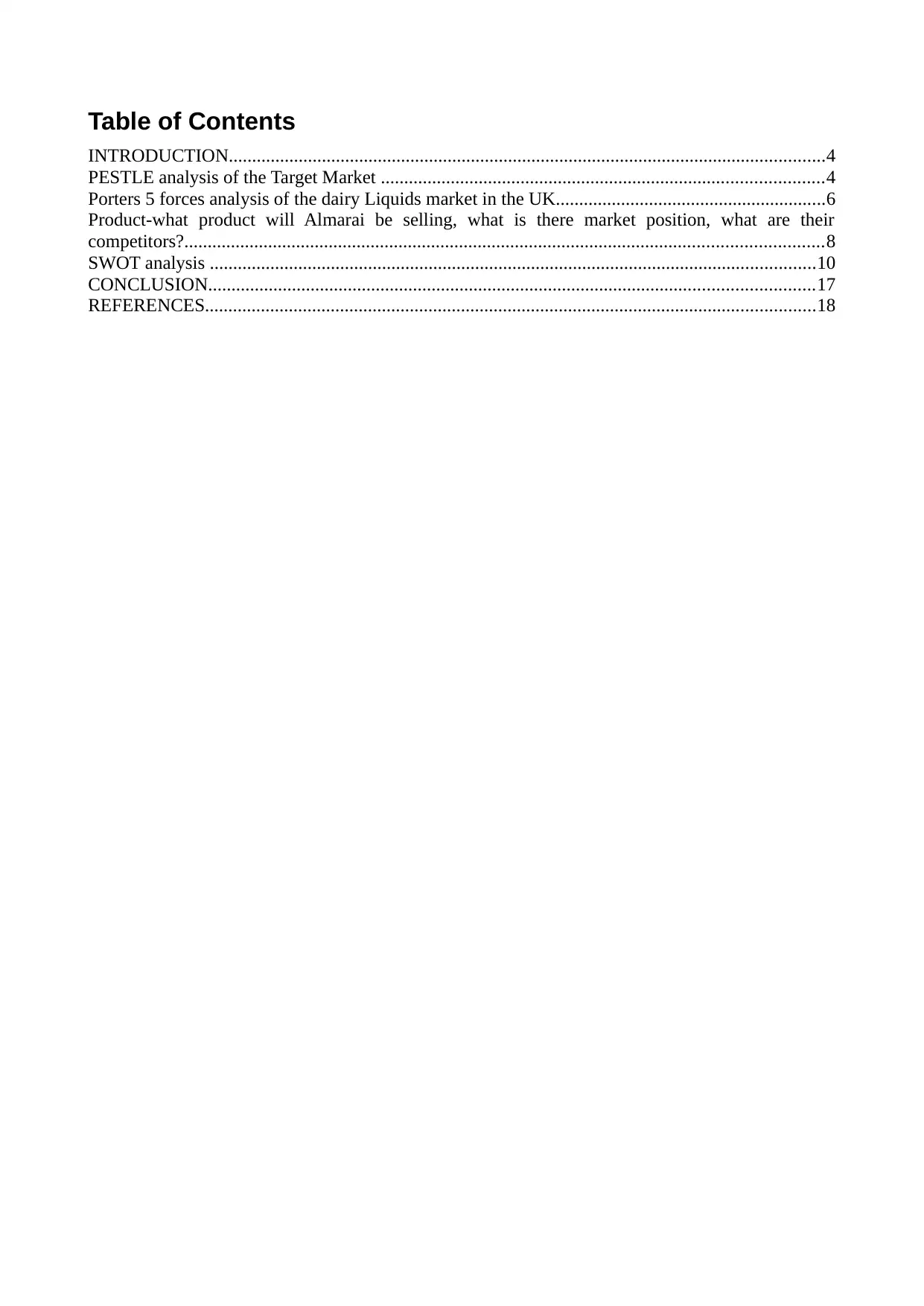
Table of Contents
INTRODUCTION................................................................................................................................4
PESTLE analysis of the Target Market ...............................................................................................4
Porters 5 forces analysis of the dairy Liquids market in the UK..........................................................6
Product-what product will Almarai be selling, what is there market position, what are their
competitors?.........................................................................................................................................8
SWOT analysis ..................................................................................................................................10
CONCLUSION..................................................................................................................................17
REFERENCES...................................................................................................................................18
INTRODUCTION................................................................................................................................4
PESTLE analysis of the Target Market ...............................................................................................4
Porters 5 forces analysis of the dairy Liquids market in the UK..........................................................6
Product-what product will Almarai be selling, what is there market position, what are their
competitors?.........................................................................................................................................8
SWOT analysis ..................................................................................................................................10
CONCLUSION..................................................................................................................................17
REFERENCES...................................................................................................................................18
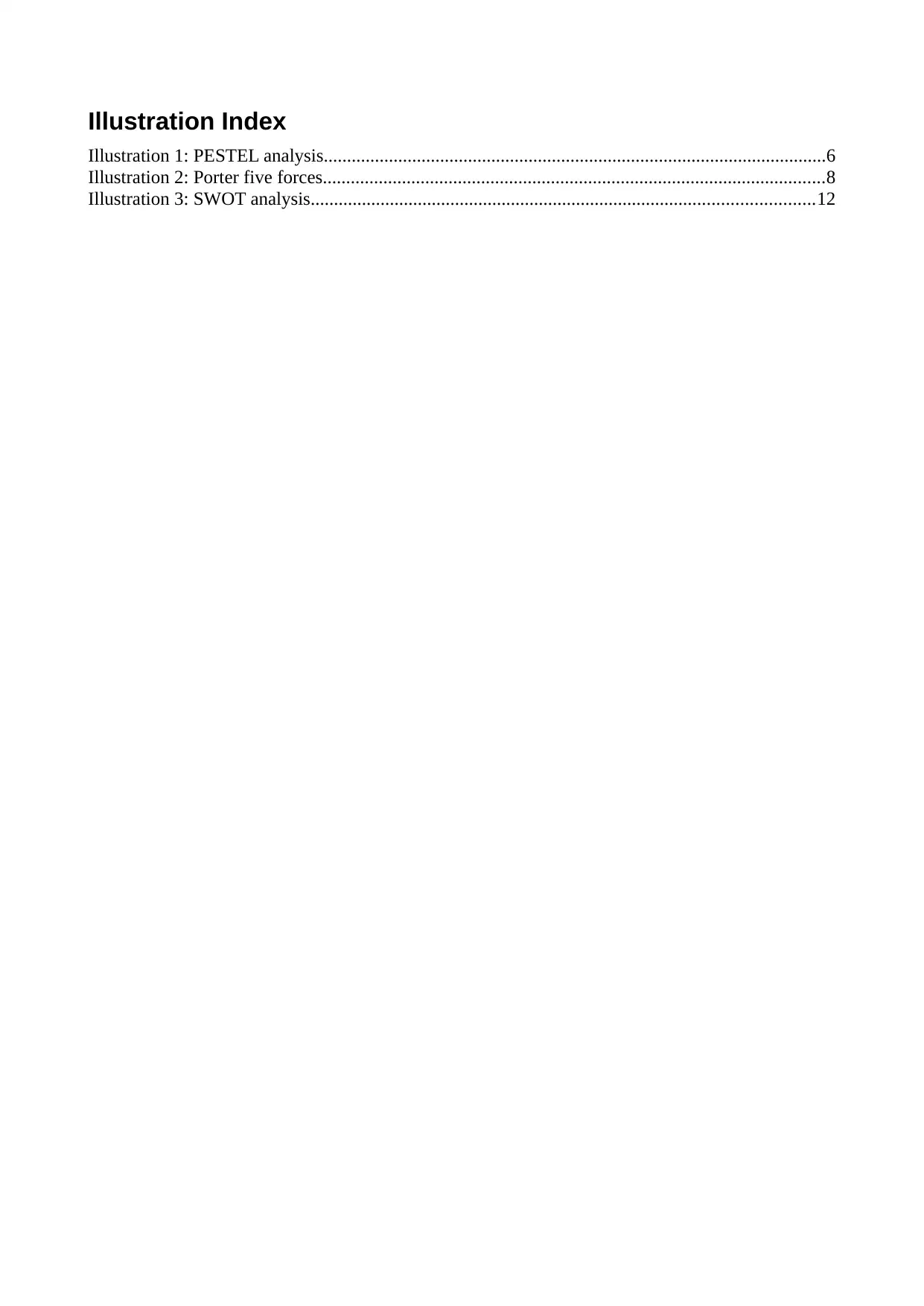
Illustration Index
Illustration 1: PESTEL analysis............................................................................................................6
Illustration 2: Porter five forces............................................................................................................8
Illustration 3: SWOT analysis............................................................................................................12
Illustration 1: PESTEL analysis............................................................................................................6
Illustration 2: Porter five forces............................................................................................................8
Illustration 3: SWOT analysis............................................................................................................12
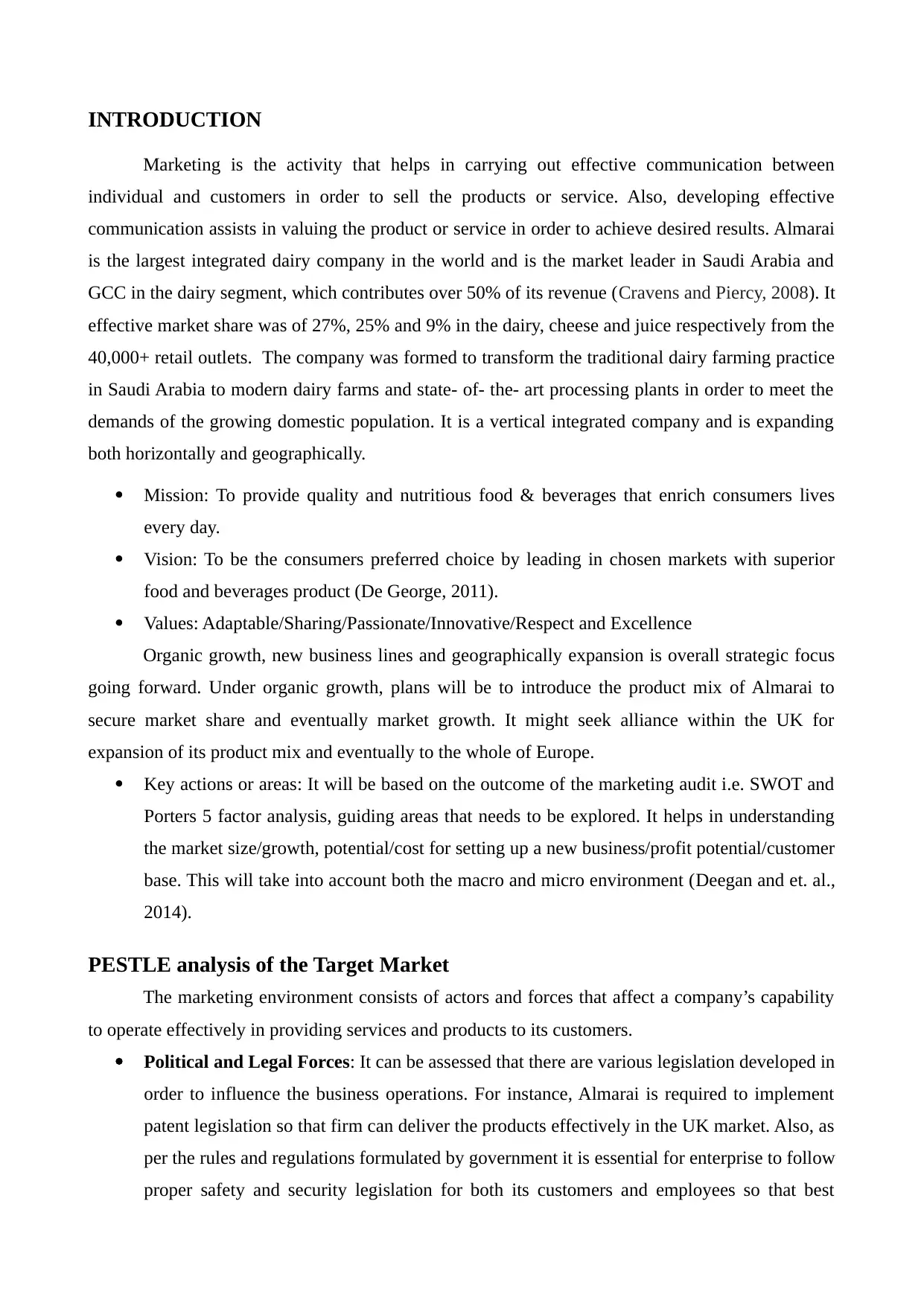
INTRODUCTION
Marketing is the activity that helps in carrying out effective communication between
individual and customers in order to sell the products or service. Also, developing effective
communication assists in valuing the product or service in order to achieve desired results. Almarai
is the largest integrated dairy company in the world and is the market leader in Saudi Arabia and
GCC in the dairy segment, which contributes over 50% of its revenue (Cravens and Piercy, 2008). It
effective market share was of 27%, 25% and 9% in the dairy, cheese and juice respectively from the
40,000+ retail outlets. The company was formed to transform the traditional dairy farming practice
in Saudi Arabia to modern dairy farms and state- of- the- art processing plants in order to meet the
demands of the growing domestic population. It is a vertical integrated company and is expanding
both horizontally and geographically.
Mission: To provide quality and nutritious food & beverages that enrich consumers lives
every day.
Vision: To be the consumers preferred choice by leading in chosen markets with superior
food and beverages product (De George, 2011).
Values: Adaptable/Sharing/Passionate/Innovative/Respect and Excellence
Organic growth, new business lines and geographically expansion is overall strategic focus
going forward. Under organic growth, plans will be to introduce the product mix of Almarai to
secure market share and eventually market growth. It might seek alliance within the UK for
expansion of its product mix and eventually to the whole of Europe.
Key actions or areas: It will be based on the outcome of the marketing audit i.e. SWOT and
Porters 5 factor analysis, guiding areas that needs to be explored. It helps in understanding
the market size/growth, potential/cost for setting up a new business/profit potential/customer
base. This will take into account both the macro and micro environment (Deegan and et. al.,
2014).
PESTLE analysis of the Target Market
The marketing environment consists of actors and forces that affect a company’s capability
to operate effectively in providing services and products to its customers.
Political and Legal Forces: It can be assessed that there are various legislation developed in
order to influence the business operations. For instance, Almarai is required to implement
patent legislation so that firm can deliver the products effectively in the UK market. Also, as
per the rules and regulations formulated by government it is essential for enterprise to follow
proper safety and security legislation for both its customers and employees so that best
Marketing is the activity that helps in carrying out effective communication between
individual and customers in order to sell the products or service. Also, developing effective
communication assists in valuing the product or service in order to achieve desired results. Almarai
is the largest integrated dairy company in the world and is the market leader in Saudi Arabia and
GCC in the dairy segment, which contributes over 50% of its revenue (Cravens and Piercy, 2008). It
effective market share was of 27%, 25% and 9% in the dairy, cheese and juice respectively from the
40,000+ retail outlets. The company was formed to transform the traditional dairy farming practice
in Saudi Arabia to modern dairy farms and state- of- the- art processing plants in order to meet the
demands of the growing domestic population. It is a vertical integrated company and is expanding
both horizontally and geographically.
Mission: To provide quality and nutritious food & beverages that enrich consumers lives
every day.
Vision: To be the consumers preferred choice by leading in chosen markets with superior
food and beverages product (De George, 2011).
Values: Adaptable/Sharing/Passionate/Innovative/Respect and Excellence
Organic growth, new business lines and geographically expansion is overall strategic focus
going forward. Under organic growth, plans will be to introduce the product mix of Almarai to
secure market share and eventually market growth. It might seek alliance within the UK for
expansion of its product mix and eventually to the whole of Europe.
Key actions or areas: It will be based on the outcome of the marketing audit i.e. SWOT and
Porters 5 factor analysis, guiding areas that needs to be explored. It helps in understanding
the market size/growth, potential/cost for setting up a new business/profit potential/customer
base. This will take into account both the macro and micro environment (Deegan and et. al.,
2014).
PESTLE analysis of the Target Market
The marketing environment consists of actors and forces that affect a company’s capability
to operate effectively in providing services and products to its customers.
Political and Legal Forces: It can be assessed that there are various legislation developed in
order to influence the business operations. For instance, Almarai is required to implement
patent legislation so that firm can deliver the products effectively in the UK market. Also, as
per the rules and regulations formulated by government it is essential for enterprise to follow
proper safety and security legislation for both its customers and employees so that best
Secure Best Marks with AI Grader
Need help grading? Try our AI Grader for instant feedback on your assignments.
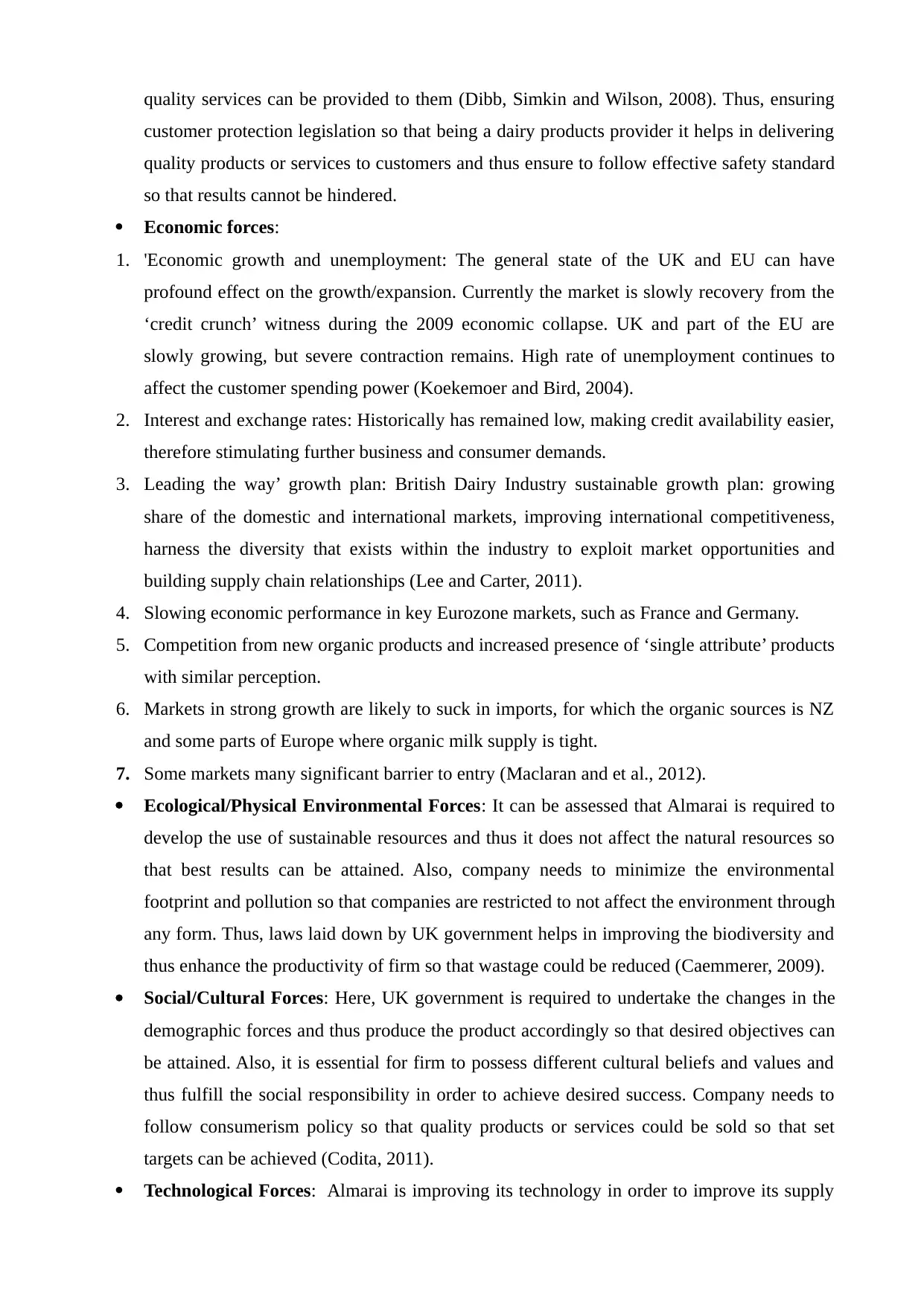
quality services can be provided to them (Dibb, Simkin and Wilson, 2008). Thus, ensuring
customer protection legislation so that being a dairy products provider it helps in delivering
quality products or services to customers and thus ensure to follow effective safety standard
so that results cannot be hindered.
Economic forces:
1. 'Economic growth and unemployment: The general state of the UK and EU can have
profound effect on the growth/expansion. Currently the market is slowly recovery from the
‘credit crunch’ witness during the 2009 economic collapse. UK and part of the EU are
slowly growing, but severe contraction remains. High rate of unemployment continues to
affect the customer spending power (Koekemoer and Bird, 2004).
2. Interest and exchange rates: Historically has remained low, making credit availability easier,
therefore stimulating further business and consumer demands.
3. Leading the way’ growth plan: British Dairy Industry sustainable growth plan: growing
share of the domestic and international markets, improving international competitiveness,
harness the diversity that exists within the industry to exploit market opportunities and
building supply chain relationships (Lee and Carter, 2011).
4. Slowing economic performance in key Eurozone markets, such as France and Germany.
5. Competition from new organic products and increased presence of ‘single attribute’ products
with similar perception.
6. Markets in strong growth are likely to suck in imports, for which the organic sources is NZ
and some parts of Europe where organic milk supply is tight.
7. Some markets many significant barrier to entry (Maclaran and et al., 2012).
Ecological/Physical Environmental Forces: It can be assessed that Almarai is required to
develop the use of sustainable resources and thus it does not affect the natural resources so
that best results can be attained. Also, company needs to minimize the environmental
footprint and pollution so that companies are restricted to not affect the environment through
any form. Thus, laws laid down by UK government helps in improving the biodiversity and
thus enhance the productivity of firm so that wastage could be reduced (Caemmerer, 2009).
Social/Cultural Forces: Here, UK government is required to undertake the changes in the
demographic forces and thus produce the product accordingly so that desired objectives can
be attained. Also, it is essential for firm to possess different cultural beliefs and values and
thus fulfill the social responsibility in order to achieve desired success. Company needs to
follow consumerism policy so that quality products or services could be sold so that set
targets can be achieved (Codita, 2011).
Technological Forces: Almarai is improving its technology in order to improve its supply
customer protection legislation so that being a dairy products provider it helps in delivering
quality products or services to customers and thus ensure to follow effective safety standard
so that results cannot be hindered.
Economic forces:
1. 'Economic growth and unemployment: The general state of the UK and EU can have
profound effect on the growth/expansion. Currently the market is slowly recovery from the
‘credit crunch’ witness during the 2009 economic collapse. UK and part of the EU are
slowly growing, but severe contraction remains. High rate of unemployment continues to
affect the customer spending power (Koekemoer and Bird, 2004).
2. Interest and exchange rates: Historically has remained low, making credit availability easier,
therefore stimulating further business and consumer demands.
3. Leading the way’ growth plan: British Dairy Industry sustainable growth plan: growing
share of the domestic and international markets, improving international competitiveness,
harness the diversity that exists within the industry to exploit market opportunities and
building supply chain relationships (Lee and Carter, 2011).
4. Slowing economic performance in key Eurozone markets, such as France and Germany.
5. Competition from new organic products and increased presence of ‘single attribute’ products
with similar perception.
6. Markets in strong growth are likely to suck in imports, for which the organic sources is NZ
and some parts of Europe where organic milk supply is tight.
7. Some markets many significant barrier to entry (Maclaran and et al., 2012).
Ecological/Physical Environmental Forces: It can be assessed that Almarai is required to
develop the use of sustainable resources and thus it does not affect the natural resources so
that best results can be attained. Also, company needs to minimize the environmental
footprint and pollution so that companies are restricted to not affect the environment through
any form. Thus, laws laid down by UK government helps in improving the biodiversity and
thus enhance the productivity of firm so that wastage could be reduced (Caemmerer, 2009).
Social/Cultural Forces: Here, UK government is required to undertake the changes in the
demographic forces and thus produce the product accordingly so that desired objectives can
be attained. Also, it is essential for firm to possess different cultural beliefs and values and
thus fulfill the social responsibility in order to achieve desired success. Company needs to
follow consumerism policy so that quality products or services could be sold so that set
targets can be achieved (Codita, 2011).
Technological Forces: Almarai is improving its technology in order to improve its supply
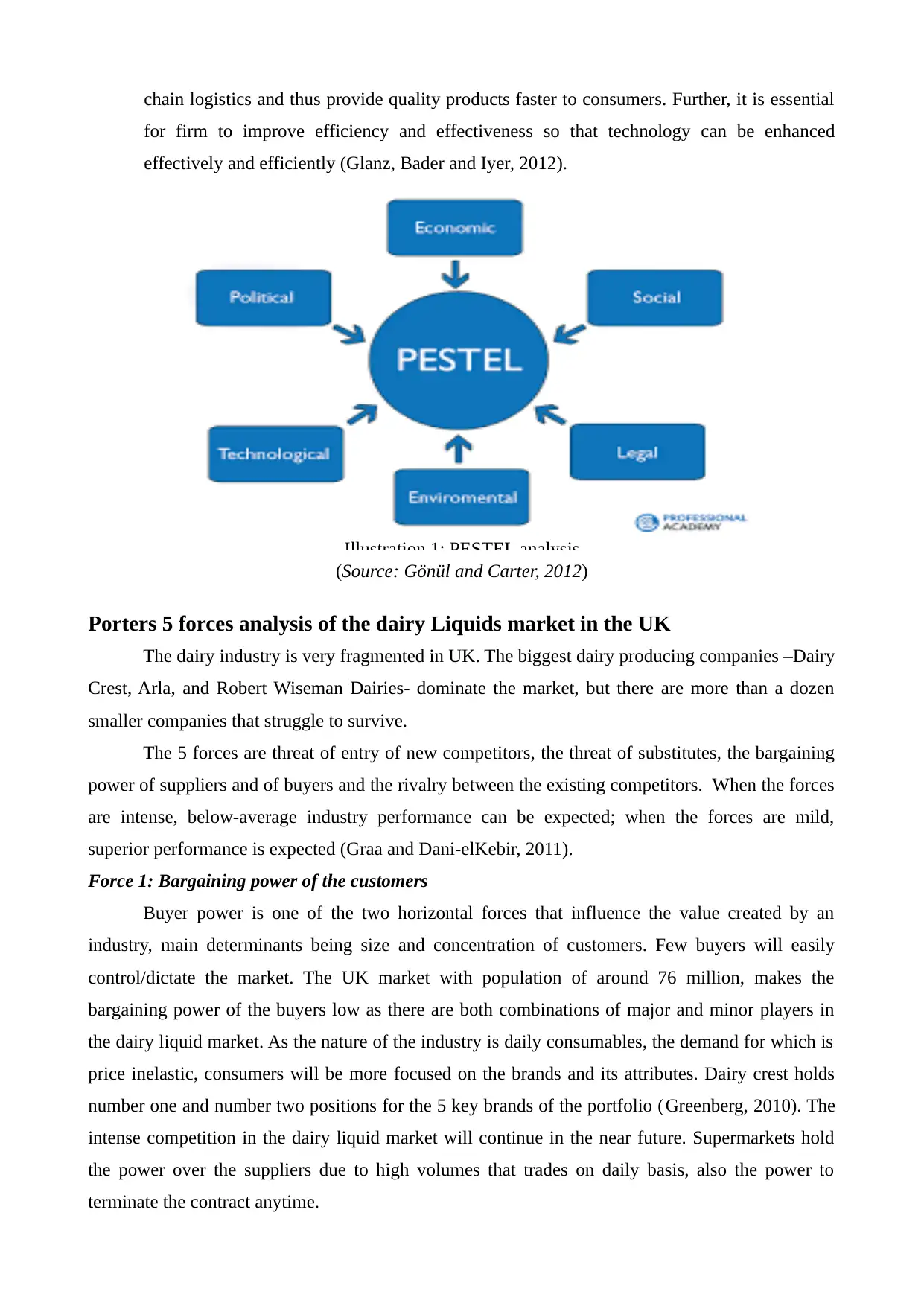
chain logistics and thus provide quality products faster to consumers. Further, it is essential
for firm to improve efficiency and effectiveness so that technology can be enhanced
effectively and efficiently (Glanz, Bader and Iyer, 2012).
Illustration 1: PESTEL analysis
(Source: Gönül and Carter, 2012)
Porters 5 forces analysis of the dairy Liquids market in the UK
The dairy industry is very fragmented in UK. The biggest dairy producing companies –Dairy
Crest, Arla, and Robert Wiseman Dairies- dominate the market, but there are more than a dozen
smaller companies that struggle to survive.
The 5 forces are threat of entry of new competitors, the threat of substitutes, the bargaining
power of suppliers and of buyers and the rivalry between the existing competitors. When the forces
are intense, below-average industry performance can be expected; when the forces are mild,
superior performance is expected (Graa and Dani-elKebir, 2011).
Force 1: Bargaining power of the customers
Buyer power is one of the two horizontal forces that influence the value created by an
industry, main determinants being size and concentration of customers. Few buyers will easily
control/dictate the market. The UK market with population of around 76 million, makes the
bargaining power of the buyers low as there are both combinations of major and minor players in
the dairy liquid market. As the nature of the industry is daily consumables, the demand for which is
price inelastic, consumers will be more focused on the brands and its attributes. Dairy crest holds
number one and number two positions for the 5 key brands of the portfolio (Greenberg, 2010). The
intense competition in the dairy liquid market will continue in the near future. Supermarkets hold
the power over the suppliers due to high volumes that trades on daily basis, also the power to
terminate the contract anytime.
for firm to improve efficiency and effectiveness so that technology can be enhanced
effectively and efficiently (Glanz, Bader and Iyer, 2012).
Illustration 1: PESTEL analysis
(Source: Gönül and Carter, 2012)
Porters 5 forces analysis of the dairy Liquids market in the UK
The dairy industry is very fragmented in UK. The biggest dairy producing companies –Dairy
Crest, Arla, and Robert Wiseman Dairies- dominate the market, but there are more than a dozen
smaller companies that struggle to survive.
The 5 forces are threat of entry of new competitors, the threat of substitutes, the bargaining
power of suppliers and of buyers and the rivalry between the existing competitors. When the forces
are intense, below-average industry performance can be expected; when the forces are mild,
superior performance is expected (Graa and Dani-elKebir, 2011).
Force 1: Bargaining power of the customers
Buyer power is one of the two horizontal forces that influence the value created by an
industry, main determinants being size and concentration of customers. Few buyers will easily
control/dictate the market. The UK market with population of around 76 million, makes the
bargaining power of the buyers low as there are both combinations of major and minor players in
the dairy liquid market. As the nature of the industry is daily consumables, the demand for which is
price inelastic, consumers will be more focused on the brands and its attributes. Dairy crest holds
number one and number two positions for the 5 key brands of the portfolio (Greenberg, 2010). The
intense competition in the dairy liquid market will continue in the near future. Supermarkets hold
the power over the suppliers due to high volumes that trades on daily basis, also the power to
terminate the contract anytime.
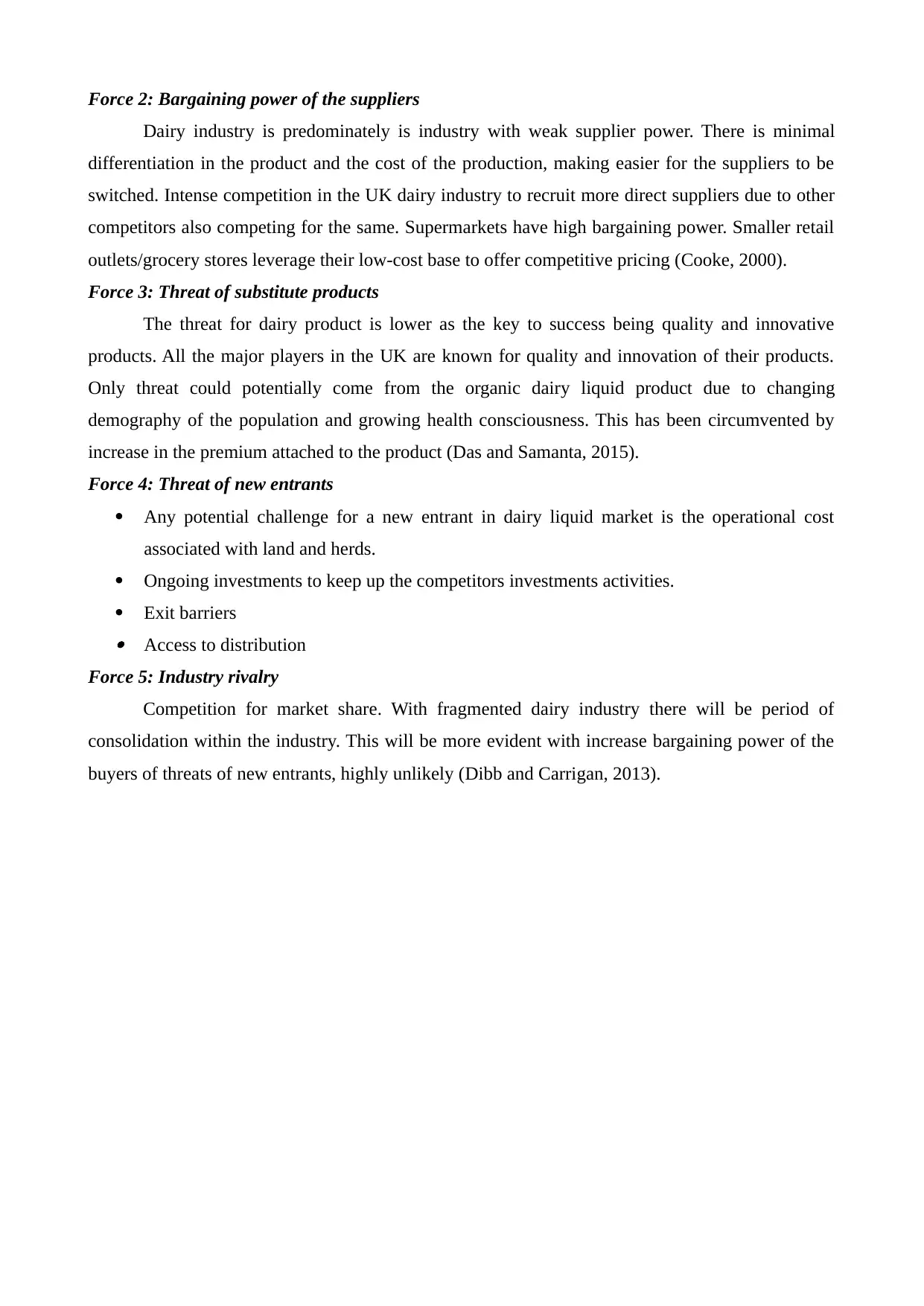
Force 2: Bargaining power of the suppliers
Dairy industry is predominately is industry with weak supplier power. There is minimal
differentiation in the product and the cost of the production, making easier for the suppliers to be
switched. Intense competition in the UK dairy industry to recruit more direct suppliers due to other
competitors also competing for the same. Supermarkets have high bargaining power. Smaller retail
outlets/grocery stores leverage their low-cost base to offer competitive pricing (Cooke, 2000).
Force 3: Threat of substitute products
The threat for dairy product is lower as the key to success being quality and innovative
products. All the major players in the UK are known for quality and innovation of their products.
Only threat could potentially come from the organic dairy liquid product due to changing
demography of the population and growing health consciousness. This has been circumvented by
increase in the premium attached to the product (Das and Samanta, 2015).
Force 4: Threat of new entrants
Any potential challenge for a new entrant in dairy liquid market is the operational cost
associated with land and herds.
Ongoing investments to keep up the competitors investments activities.
Exit barriers Access to distribution
Force 5: Industry rivalry
Competition for market share. With fragmented dairy industry there will be period of
consolidation within the industry. This will be more evident with increase bargaining power of the
buyers of threats of new entrants, highly unlikely (Dibb and Carrigan, 2013).
Dairy industry is predominately is industry with weak supplier power. There is minimal
differentiation in the product and the cost of the production, making easier for the suppliers to be
switched. Intense competition in the UK dairy industry to recruit more direct suppliers due to other
competitors also competing for the same. Supermarkets have high bargaining power. Smaller retail
outlets/grocery stores leverage their low-cost base to offer competitive pricing (Cooke, 2000).
Force 3: Threat of substitute products
The threat for dairy product is lower as the key to success being quality and innovative
products. All the major players in the UK are known for quality and innovation of their products.
Only threat could potentially come from the organic dairy liquid product due to changing
demography of the population and growing health consciousness. This has been circumvented by
increase in the premium attached to the product (Das and Samanta, 2015).
Force 4: Threat of new entrants
Any potential challenge for a new entrant in dairy liquid market is the operational cost
associated with land and herds.
Ongoing investments to keep up the competitors investments activities.
Exit barriers Access to distribution
Force 5: Industry rivalry
Competition for market share. With fragmented dairy industry there will be period of
consolidation within the industry. This will be more evident with increase bargaining power of the
buyers of threats of new entrants, highly unlikely (Dibb and Carrigan, 2013).
Paraphrase This Document
Need a fresh take? Get an instant paraphrase of this document with our AI Paraphraser
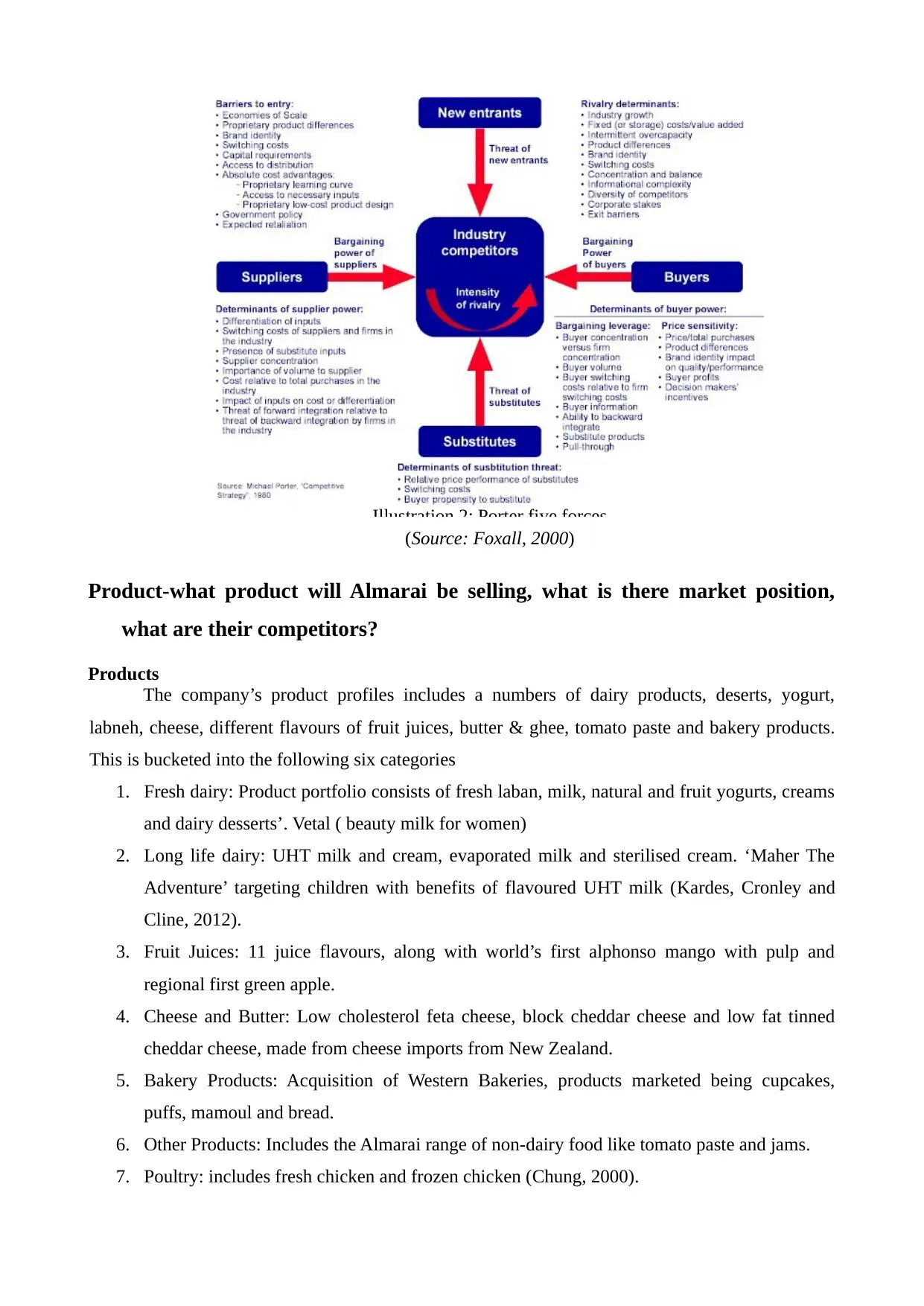
Illustration 2: Porter five forces
(Source: Foxall, 2000)
Product-what product will Almarai be selling, what is there market position,
what are their competitors?
Products
The company’s product profiles includes a numbers of dairy products, deserts, yogurt,
labneh, cheese, different flavours of fruit juices, butter & ghee, tomato paste and bakery products.
This is bucketed into the following six categories
1. Fresh dairy: Product portfolio consists of fresh laban, milk, natural and fruit yogurts, creams
and dairy desserts’. Vetal ( beauty milk for women)
2. Long life dairy: UHT milk and cream, evaporated milk and sterilised cream. ‘Maher The
Adventure’ targeting children with benefits of flavoured UHT milk (Kardes, Cronley and
Cline, 2012).
3. Fruit Juices: 11 juice flavours, along with world’s first alphonso mango with pulp and
regional first green apple.
4. Cheese and Butter: Low cholesterol feta cheese, block cheddar cheese and low fat tinned
cheddar cheese, made from cheese imports from New Zealand.
5. Bakery Products: Acquisition of Western Bakeries, products marketed being cupcakes,
puffs, mamoul and bread.
6. Other Products: Includes the Almarai range of non-dairy food like tomato paste and jams.
7. Poultry: includes fresh chicken and frozen chicken (Chung, 2000).
(Source: Foxall, 2000)
Product-what product will Almarai be selling, what is there market position,
what are their competitors?
Products
The company’s product profiles includes a numbers of dairy products, deserts, yogurt,
labneh, cheese, different flavours of fruit juices, butter & ghee, tomato paste and bakery products.
This is bucketed into the following six categories
1. Fresh dairy: Product portfolio consists of fresh laban, milk, natural and fruit yogurts, creams
and dairy desserts’. Vetal ( beauty milk for women)
2. Long life dairy: UHT milk and cream, evaporated milk and sterilised cream. ‘Maher The
Adventure’ targeting children with benefits of flavoured UHT milk (Kardes, Cronley and
Cline, 2012).
3. Fruit Juices: 11 juice flavours, along with world’s first alphonso mango with pulp and
regional first green apple.
4. Cheese and Butter: Low cholesterol feta cheese, block cheddar cheese and low fat tinned
cheddar cheese, made from cheese imports from New Zealand.
5. Bakery Products: Acquisition of Western Bakeries, products marketed being cupcakes,
puffs, mamoul and bread.
6. Other Products: Includes the Almarai range of non-dairy food like tomato paste and jams.
7. Poultry: includes fresh chicken and frozen chicken (Chung, 2000).
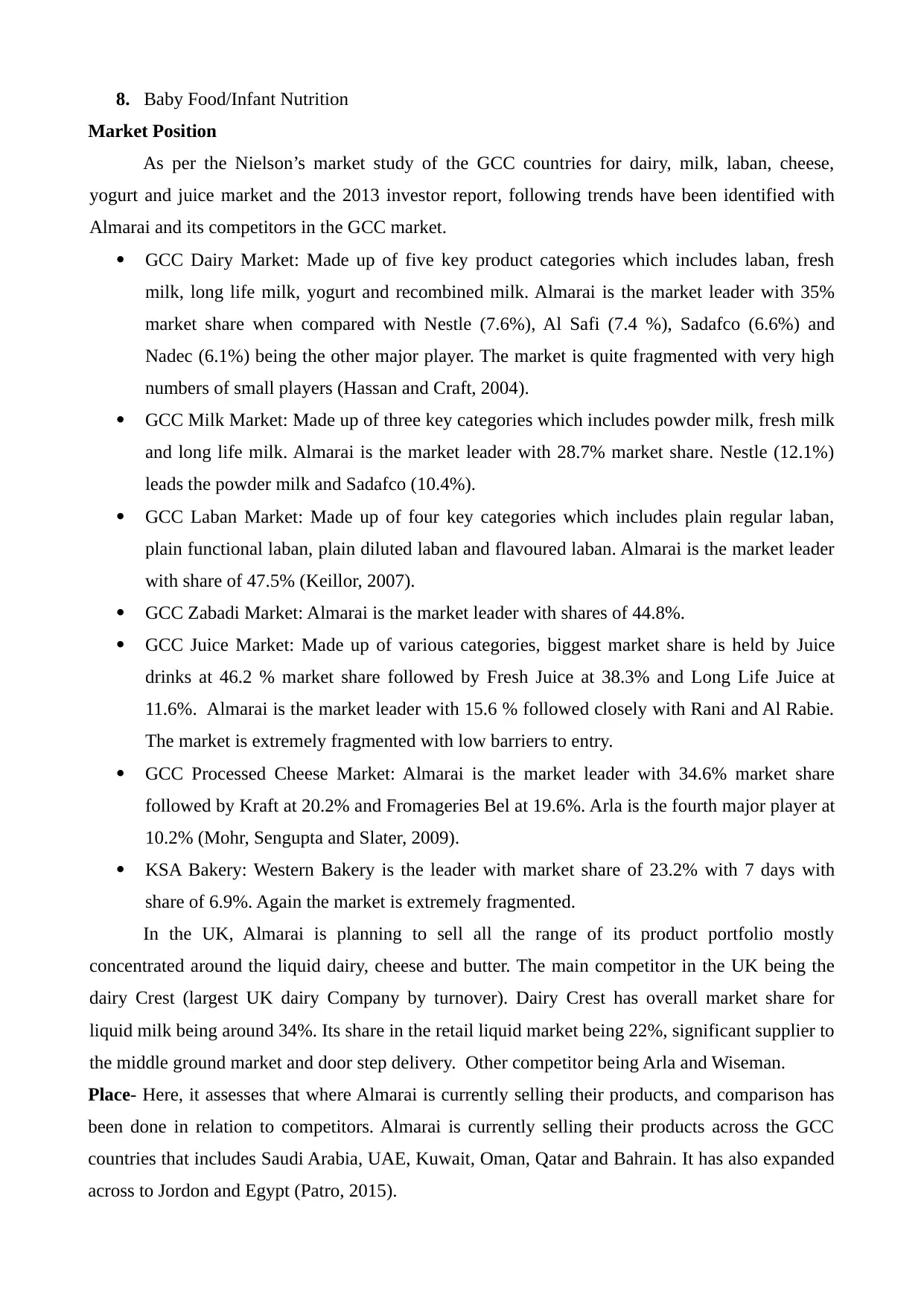
8. Baby Food/Infant Nutrition
Market Position
As per the Nielson’s market study of the GCC countries for dairy, milk, laban, cheese,
yogurt and juice market and the 2013 investor report, following trends have been identified with
Almarai and its competitors in the GCC market.
GCC Dairy Market: Made up of five key product categories which includes laban, fresh
milk, long life milk, yogurt and recombined milk. Almarai is the market leader with 35%
market share when compared with Nestle (7.6%), Al Safi (7.4 %), Sadafco (6.6%) and
Nadec (6.1%) being the other major player. The market is quite fragmented with very high
numbers of small players (Hassan and Craft, 2004).
GCC Milk Market: Made up of three key categories which includes powder milk, fresh milk
and long life milk. Almarai is the market leader with 28.7% market share. Nestle (12.1%)
leads the powder milk and Sadafco (10.4%).
GCC Laban Market: Made up of four key categories which includes plain regular laban,
plain functional laban, plain diluted laban and flavoured laban. Almarai is the market leader
with share of 47.5% (Keillor, 2007).
GCC Zabadi Market: Almarai is the market leader with shares of 44.8%.
GCC Juice Market: Made up of various categories, biggest market share is held by Juice
drinks at 46.2 % market share followed by Fresh Juice at 38.3% and Long Life Juice at
11.6%. Almarai is the market leader with 15.6 % followed closely with Rani and Al Rabie.
The market is extremely fragmented with low barriers to entry.
GCC Processed Cheese Market: Almarai is the market leader with 34.6% market share
followed by Kraft at 20.2% and Fromageries Bel at 19.6%. Arla is the fourth major player at
10.2% (Mohr, Sengupta and Slater, 2009).
KSA Bakery: Western Bakery is the leader with market share of 23.2% with 7 days with
share of 6.9%. Again the market is extremely fragmented.
In the UK, Almarai is planning to sell all the range of its product portfolio mostly
concentrated around the liquid dairy, cheese and butter. The main competitor in the UK being the
dairy Crest (largest UK dairy Company by turnover). Dairy Crest has overall market share for
liquid milk being around 34%. Its share in the retail liquid market being 22%, significant supplier to
the middle ground market and door step delivery. Other competitor being Arla and Wiseman.
Place- Here, it assesses that where Almarai is currently selling their products, and comparison has
been done in relation to competitors. Almarai is currently selling their products across the GCC
countries that includes Saudi Arabia, UAE, Kuwait, Oman, Qatar and Bahrain. It has also expanded
across to Jordon and Egypt (Patro, 2015).
Market Position
As per the Nielson’s market study of the GCC countries for dairy, milk, laban, cheese,
yogurt and juice market and the 2013 investor report, following trends have been identified with
Almarai and its competitors in the GCC market.
GCC Dairy Market: Made up of five key product categories which includes laban, fresh
milk, long life milk, yogurt and recombined milk. Almarai is the market leader with 35%
market share when compared with Nestle (7.6%), Al Safi (7.4 %), Sadafco (6.6%) and
Nadec (6.1%) being the other major player. The market is quite fragmented with very high
numbers of small players (Hassan and Craft, 2004).
GCC Milk Market: Made up of three key categories which includes powder milk, fresh milk
and long life milk. Almarai is the market leader with 28.7% market share. Nestle (12.1%)
leads the powder milk and Sadafco (10.4%).
GCC Laban Market: Made up of four key categories which includes plain regular laban,
plain functional laban, plain diluted laban and flavoured laban. Almarai is the market leader
with share of 47.5% (Keillor, 2007).
GCC Zabadi Market: Almarai is the market leader with shares of 44.8%.
GCC Juice Market: Made up of various categories, biggest market share is held by Juice
drinks at 46.2 % market share followed by Fresh Juice at 38.3% and Long Life Juice at
11.6%. Almarai is the market leader with 15.6 % followed closely with Rani and Al Rabie.
The market is extremely fragmented with low barriers to entry.
GCC Processed Cheese Market: Almarai is the market leader with 34.6% market share
followed by Kraft at 20.2% and Fromageries Bel at 19.6%. Arla is the fourth major player at
10.2% (Mohr, Sengupta and Slater, 2009).
KSA Bakery: Western Bakery is the leader with market share of 23.2% with 7 days with
share of 6.9%. Again the market is extremely fragmented.
In the UK, Almarai is planning to sell all the range of its product portfolio mostly
concentrated around the liquid dairy, cheese and butter. The main competitor in the UK being the
dairy Crest (largest UK dairy Company by turnover). Dairy Crest has overall market share for
liquid milk being around 34%. Its share in the retail liquid market being 22%, significant supplier to
the middle ground market and door step delivery. Other competitor being Arla and Wiseman.
Place- Here, it assesses that where Almarai is currently selling their products, and comparison has
been done in relation to competitors. Almarai is currently selling their products across the GCC
countries that includes Saudi Arabia, UAE, Kuwait, Oman, Qatar and Bahrain. It has also expanded
across to Jordon and Egypt (Patro, 2015).
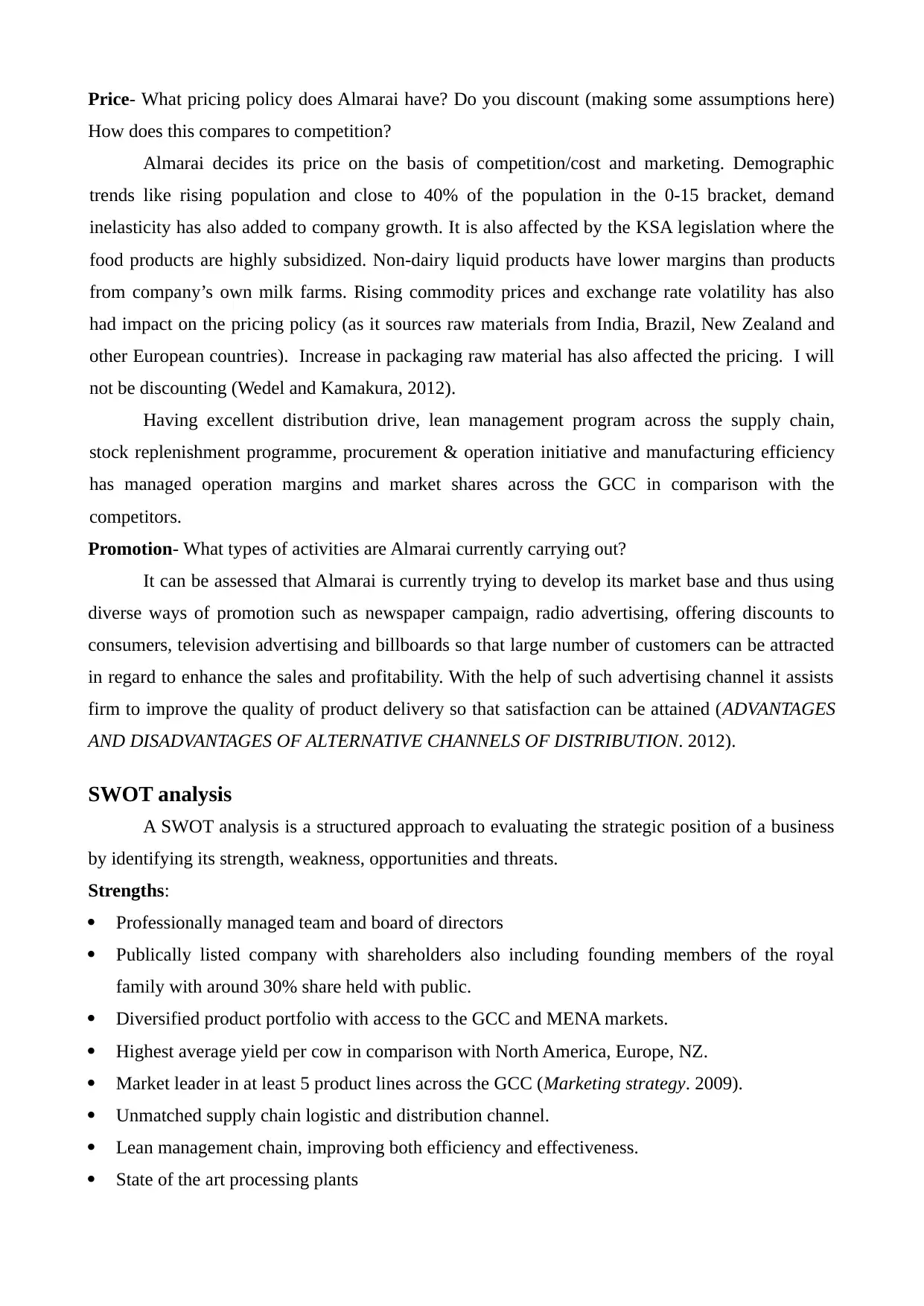
Price- What pricing policy does Almarai have? Do you discount (making some assumptions here)
How does this compares to competition?
Almarai decides its price on the basis of competition/cost and marketing. Demographic
trends like rising population and close to 40% of the population in the 0-15 bracket, demand
inelasticity has also added to company growth. It is also affected by the KSA legislation where the
food products are highly subsidized. Non-dairy liquid products have lower margins than products
from company’s own milk farms. Rising commodity prices and exchange rate volatility has also
had impact on the pricing policy (as it sources raw materials from India, Brazil, New Zealand and
other European countries). Increase in packaging raw material has also affected the pricing. I will
not be discounting (Wedel and Kamakura, 2012).
Having excellent distribution drive, lean management program across the supply chain,
stock replenishment programme, procurement & operation initiative and manufacturing efficiency
has managed operation margins and market shares across the GCC in comparison with the
competitors.
Promotion- What types of activities are Almarai currently carrying out?
It can be assessed that Almarai is currently trying to develop its market base and thus using
diverse ways of promotion such as newspaper campaign, radio advertising, offering discounts to
consumers, television advertising and billboards so that large number of customers can be attracted
in regard to enhance the sales and profitability. With the help of such advertising channel it assists
firm to improve the quality of product delivery so that satisfaction can be attained (ADVANTAGES
AND DISADVANTAGES OF ALTERNATIVE CHANNELS OF DISTRIBUTION. 2012).
SWOT analysis
A SWOT analysis is a structured approach to evaluating the strategic position of a business
by identifying its strength, weakness, opportunities and threats.
Strengths:
Professionally managed team and board of directors
Publically listed company with shareholders also including founding members of the royal
family with around 30% share held with public.
Diversified product portfolio with access to the GCC and MENA markets.
Highest average yield per cow in comparison with North America, Europe, NZ.
Market leader in at least 5 product lines across the GCC (Marketing strategy. 2009).
Unmatched supply chain logistic and distribution channel.
Lean management chain, improving both efficiency and effectiveness.
State of the art processing plants
How does this compares to competition?
Almarai decides its price on the basis of competition/cost and marketing. Demographic
trends like rising population and close to 40% of the population in the 0-15 bracket, demand
inelasticity has also added to company growth. It is also affected by the KSA legislation where the
food products are highly subsidized. Non-dairy liquid products have lower margins than products
from company’s own milk farms. Rising commodity prices and exchange rate volatility has also
had impact on the pricing policy (as it sources raw materials from India, Brazil, New Zealand and
other European countries). Increase in packaging raw material has also affected the pricing. I will
not be discounting (Wedel and Kamakura, 2012).
Having excellent distribution drive, lean management program across the supply chain,
stock replenishment programme, procurement & operation initiative and manufacturing efficiency
has managed operation margins and market shares across the GCC in comparison with the
competitors.
Promotion- What types of activities are Almarai currently carrying out?
It can be assessed that Almarai is currently trying to develop its market base and thus using
diverse ways of promotion such as newspaper campaign, radio advertising, offering discounts to
consumers, television advertising and billboards so that large number of customers can be attracted
in regard to enhance the sales and profitability. With the help of such advertising channel it assists
firm to improve the quality of product delivery so that satisfaction can be attained (ADVANTAGES
AND DISADVANTAGES OF ALTERNATIVE CHANNELS OF DISTRIBUTION. 2012).
SWOT analysis
A SWOT analysis is a structured approach to evaluating the strategic position of a business
by identifying its strength, weakness, opportunities and threats.
Strengths:
Professionally managed team and board of directors
Publically listed company with shareholders also including founding members of the royal
family with around 30% share held with public.
Diversified product portfolio with access to the GCC and MENA markets.
Highest average yield per cow in comparison with North America, Europe, NZ.
Market leader in at least 5 product lines across the GCC (Marketing strategy. 2009).
Unmatched supply chain logistic and distribution channel.
Lean management chain, improving both efficiency and effectiveness.
State of the art processing plants
Secure Best Marks with AI Grader
Need help grading? Try our AI Grader for instant feedback on your assignments.
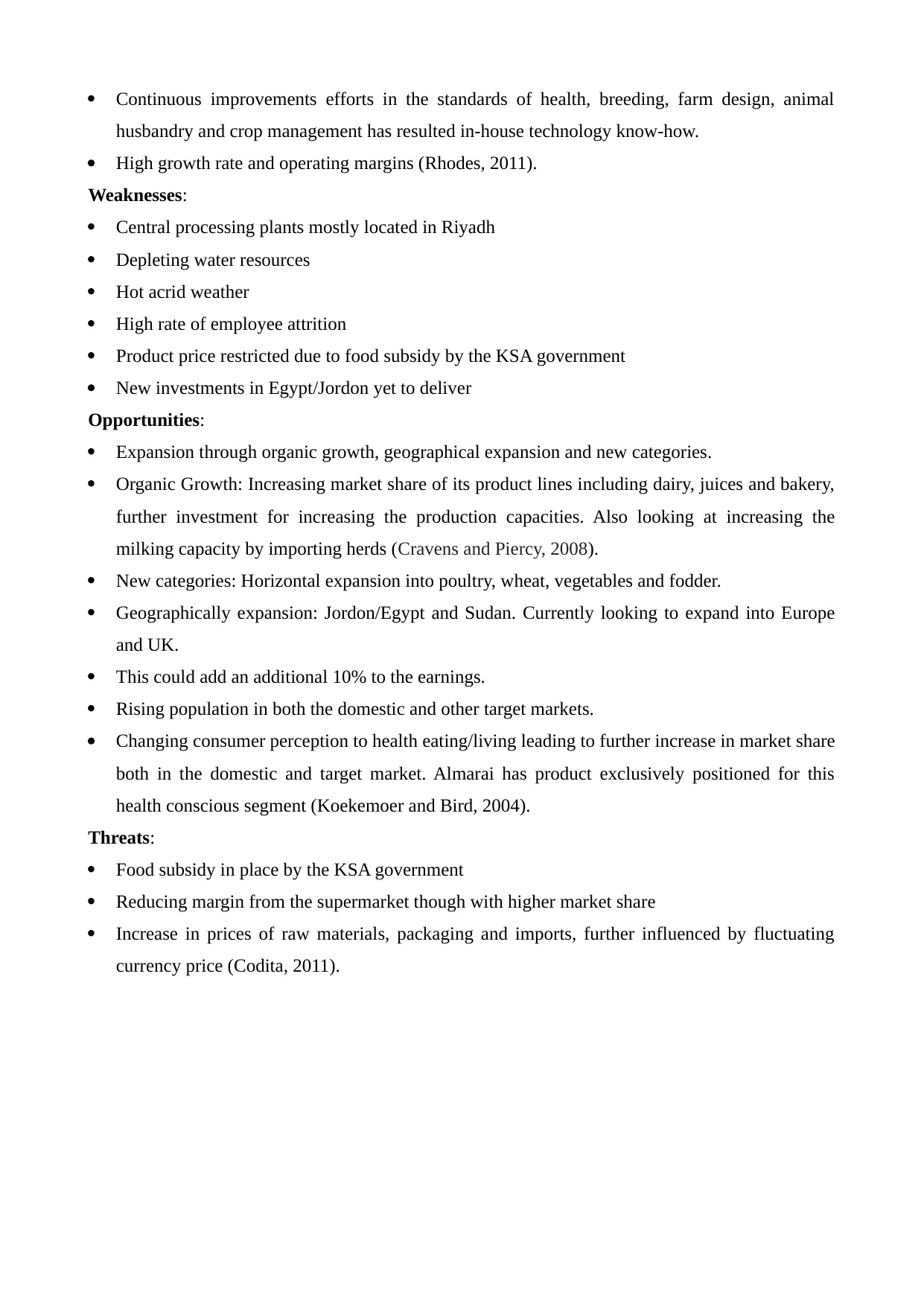
Continuous improvements efforts in the standards of health, breeding, farm design, animal
husbandry and crop management has resulted in-house technology know-how.
High growth rate and operating margins (Rhodes, 2011).
Weaknesses:
Central processing plants mostly located in Riyadh
Depleting water resources
Hot acrid weather
High rate of employee attrition
Product price restricted due to food subsidy by the KSA government
New investments in Egypt/Jordon yet to deliver
Opportunities:
Expansion through organic growth, geographical expansion and new categories.
Organic Growth: Increasing market share of its product lines including dairy, juices and bakery,
further investment for increasing the production capacities. Also looking at increasing the
milking capacity by importing herds (Cravens and Piercy, 2008).
New categories: Horizontal expansion into poultry, wheat, vegetables and fodder.
Geographically expansion: Jordon/Egypt and Sudan. Currently looking to expand into Europe
and UK.
This could add an additional 10% to the earnings.
Rising population in both the domestic and other target markets.
Changing consumer perception to health eating/living leading to further increase in market share
both in the domestic and target market. Almarai has product exclusively positioned for this
health conscious segment (Koekemoer and Bird, 2004).
Threats:
Food subsidy in place by the KSA government
Reducing margin from the supermarket though with higher market share
Increase in prices of raw materials, packaging and imports, further influenced by fluctuating
currency price (Codita, 2011).
husbandry and crop management has resulted in-house technology know-how.
High growth rate and operating margins (Rhodes, 2011).
Weaknesses:
Central processing plants mostly located in Riyadh
Depleting water resources
Hot acrid weather
High rate of employee attrition
Product price restricted due to food subsidy by the KSA government
New investments in Egypt/Jordon yet to deliver
Opportunities:
Expansion through organic growth, geographical expansion and new categories.
Organic Growth: Increasing market share of its product lines including dairy, juices and bakery,
further investment for increasing the production capacities. Also looking at increasing the
milking capacity by importing herds (Cravens and Piercy, 2008).
New categories: Horizontal expansion into poultry, wheat, vegetables and fodder.
Geographically expansion: Jordon/Egypt and Sudan. Currently looking to expand into Europe
and UK.
This could add an additional 10% to the earnings.
Rising population in both the domestic and other target markets.
Changing consumer perception to health eating/living leading to further increase in market share
both in the domestic and target market. Almarai has product exclusively positioned for this
health conscious segment (Koekemoer and Bird, 2004).
Threats:
Food subsidy in place by the KSA government
Reducing margin from the supermarket though with higher market share
Increase in prices of raw materials, packaging and imports, further influenced by fluctuating
currency price (Codita, 2011).
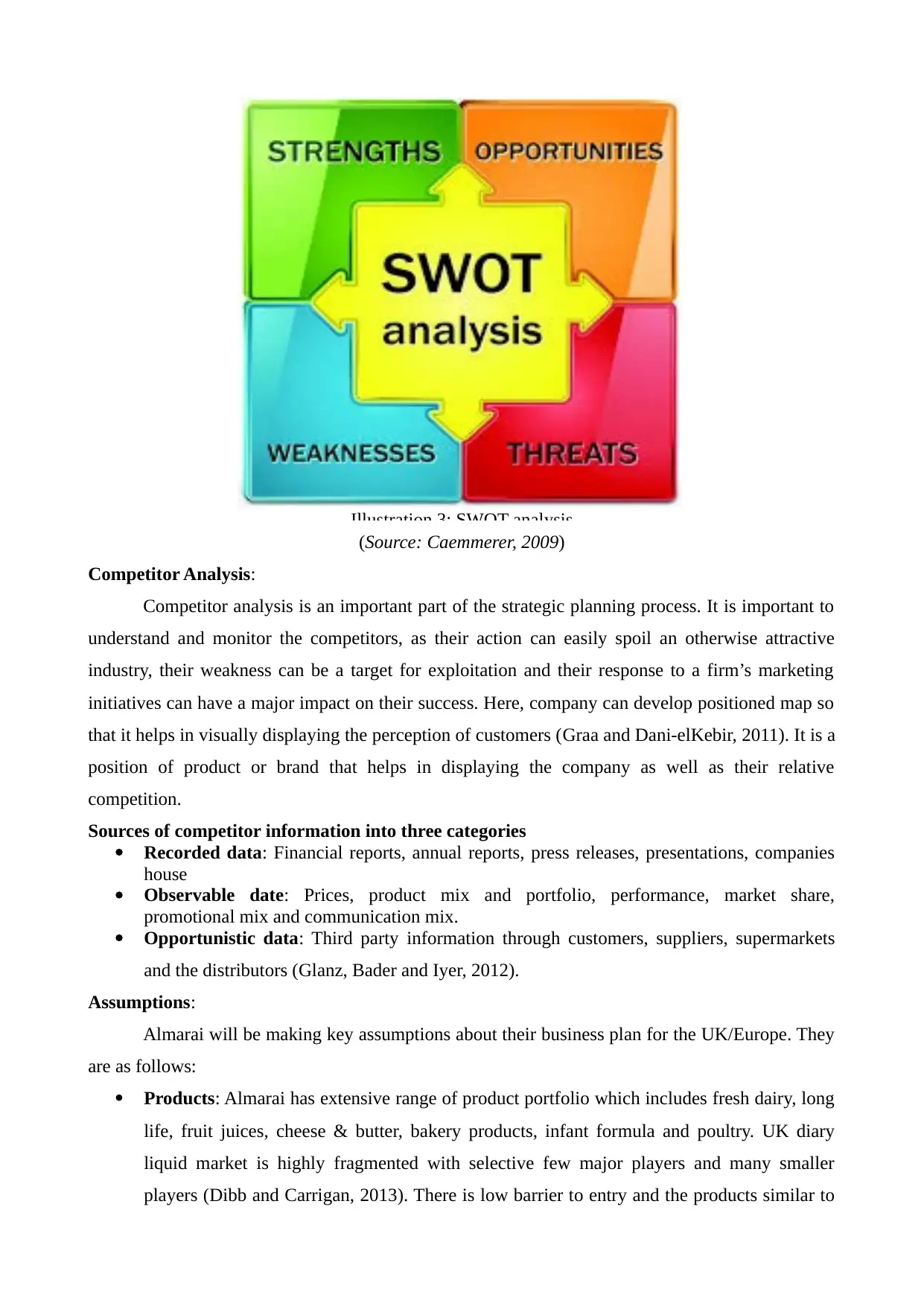
Illustration 3: SWOT analysis
(Source: Caemmerer, 2009)
Competitor Analysis:
Competitor analysis is an important part of the strategic planning process. It is important to
understand and monitor the competitors, as their action can easily spoil an otherwise attractive
industry, their weakness can be a target for exploitation and their response to a firm’s marketing
initiatives can have a major impact on their success. Here, company can develop positioned map so
that it helps in visually displaying the perception of customers (Graa and Dani-elKebir, 2011). It is a
position of product or brand that helps in displaying the company as well as their relative
competition.
Sources of competitor information into three categories
Recorded data: Financial reports, annual reports, press releases, presentations, companies
house
Observable date: Prices, product mix and portfolio, performance, market share,
promotional mix and communication mix.
Opportunistic data: Third party information through customers, suppliers, supermarkets
and the distributors (Glanz, Bader and Iyer, 2012).
Assumptions:
Almarai will be making key assumptions about their business plan for the UK/Europe. They
are as follows:
Products: Almarai has extensive range of product portfolio which includes fresh dairy, long
life, fruit juices, cheese & butter, bakery products, infant formula and poultry. UK diary
liquid market is highly fragmented with selective few major players and many smaller
players (Dibb and Carrigan, 2013). There is low barrier to entry and the products similar to
(Source: Caemmerer, 2009)
Competitor Analysis:
Competitor analysis is an important part of the strategic planning process. It is important to
understand and monitor the competitors, as their action can easily spoil an otherwise attractive
industry, their weakness can be a target for exploitation and their response to a firm’s marketing
initiatives can have a major impact on their success. Here, company can develop positioned map so
that it helps in visually displaying the perception of customers (Graa and Dani-elKebir, 2011). It is a
position of product or brand that helps in displaying the company as well as their relative
competition.
Sources of competitor information into three categories
Recorded data: Financial reports, annual reports, press releases, presentations, companies
house
Observable date: Prices, product mix and portfolio, performance, market share,
promotional mix and communication mix.
Opportunistic data: Third party information through customers, suppliers, supermarkets
and the distributors (Glanz, Bader and Iyer, 2012).
Assumptions:
Almarai will be making key assumptions about their business plan for the UK/Europe. They
are as follows:
Products: Almarai has extensive range of product portfolio which includes fresh dairy, long
life, fruit juices, cheese & butter, bakery products, infant formula and poultry. UK diary
liquid market is highly fragmented with selective few major players and many smaller
players (Dibb and Carrigan, 2013). There is low barrier to entry and the products similar to
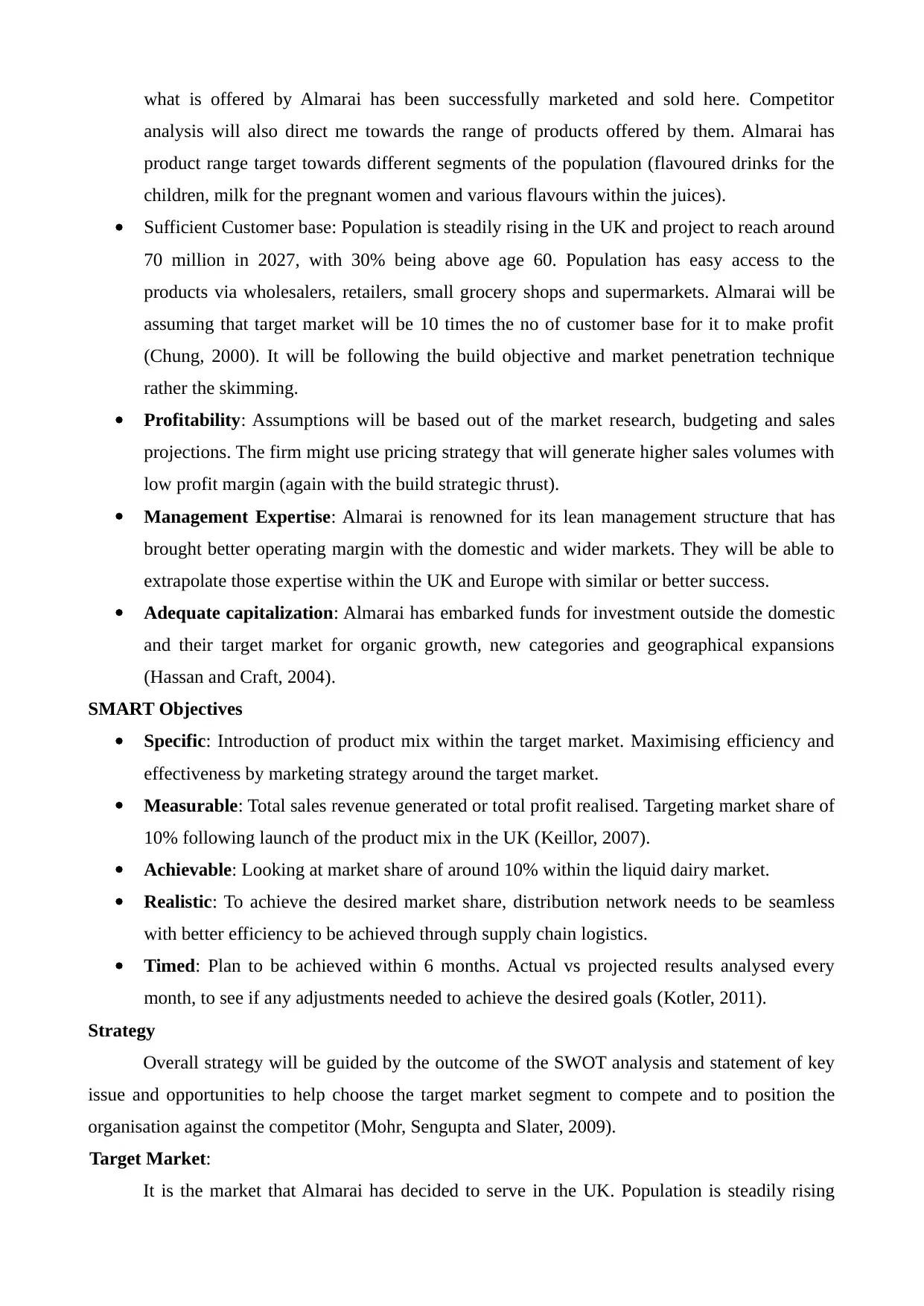
what is offered by Almarai has been successfully marketed and sold here. Competitor
analysis will also direct me towards the range of products offered by them. Almarai has
product range target towards different segments of the population (flavoured drinks for the
children, milk for the pregnant women and various flavours within the juices).
Sufficient Customer base: Population is steadily rising in the UK and project to reach around
70 million in 2027, with 30% being above age 60. Population has easy access to the
products via wholesalers, retailers, small grocery shops and supermarkets. Almarai will be
assuming that target market will be 10 times the no of customer base for it to make profit
(Chung, 2000). It will be following the build objective and market penetration technique
rather the skimming.
Profitability: Assumptions will be based out of the market research, budgeting and sales
projections. The firm might use pricing strategy that will generate higher sales volumes with
low profit margin (again with the build strategic thrust).
Management Expertise: Almarai is renowned for its lean management structure that has
brought better operating margin with the domestic and wider markets. They will be able to
extrapolate those expertise within the UK and Europe with similar or better success.
Adequate capitalization: Almarai has embarked funds for investment outside the domestic
and their target market for organic growth, new categories and geographical expansions
(Hassan and Craft, 2004).
SMART Objectives
Specific: Introduction of product mix within the target market. Maximising efficiency and
effectiveness by marketing strategy around the target market.
Measurable: Total sales revenue generated or total profit realised. Targeting market share of
10% following launch of the product mix in the UK (Keillor, 2007).
Achievable: Looking at market share of around 10% within the liquid dairy market.
Realistic: To achieve the desired market share, distribution network needs to be seamless
with better efficiency to be achieved through supply chain logistics.
Timed: Plan to be achieved within 6 months. Actual vs projected results analysed every
month, to see if any adjustments needed to achieve the desired goals (Kotler, 2011).
Strategy
Overall strategy will be guided by the outcome of the SWOT analysis and statement of key
issue and opportunities to help choose the target market segment to compete and to position the
organisation against the competitor (Mohr, Sengupta and Slater, 2009).
Target Market:
It is the market that Almarai has decided to serve in the UK. Population is steadily rising
analysis will also direct me towards the range of products offered by them. Almarai has
product range target towards different segments of the population (flavoured drinks for the
children, milk for the pregnant women and various flavours within the juices).
Sufficient Customer base: Population is steadily rising in the UK and project to reach around
70 million in 2027, with 30% being above age 60. Population has easy access to the
products via wholesalers, retailers, small grocery shops and supermarkets. Almarai will be
assuming that target market will be 10 times the no of customer base for it to make profit
(Chung, 2000). It will be following the build objective and market penetration technique
rather the skimming.
Profitability: Assumptions will be based out of the market research, budgeting and sales
projections. The firm might use pricing strategy that will generate higher sales volumes with
low profit margin (again with the build strategic thrust).
Management Expertise: Almarai is renowned for its lean management structure that has
brought better operating margin with the domestic and wider markets. They will be able to
extrapolate those expertise within the UK and Europe with similar or better success.
Adequate capitalization: Almarai has embarked funds for investment outside the domestic
and their target market for organic growth, new categories and geographical expansions
(Hassan and Craft, 2004).
SMART Objectives
Specific: Introduction of product mix within the target market. Maximising efficiency and
effectiveness by marketing strategy around the target market.
Measurable: Total sales revenue generated or total profit realised. Targeting market share of
10% following launch of the product mix in the UK (Keillor, 2007).
Achievable: Looking at market share of around 10% within the liquid dairy market.
Realistic: To achieve the desired market share, distribution network needs to be seamless
with better efficiency to be achieved through supply chain logistics.
Timed: Plan to be achieved within 6 months. Actual vs projected results analysed every
month, to see if any adjustments needed to achieve the desired goals (Kotler, 2011).
Strategy
Overall strategy will be guided by the outcome of the SWOT analysis and statement of key
issue and opportunities to help choose the target market segment to compete and to position the
organisation against the competitor (Mohr, Sengupta and Slater, 2009).
Target Market:
It is the market that Almarai has decided to serve in the UK. Population is steadily rising
Paraphrase This Document
Need a fresh take? Get an instant paraphrase of this document with our AI Paraphraser
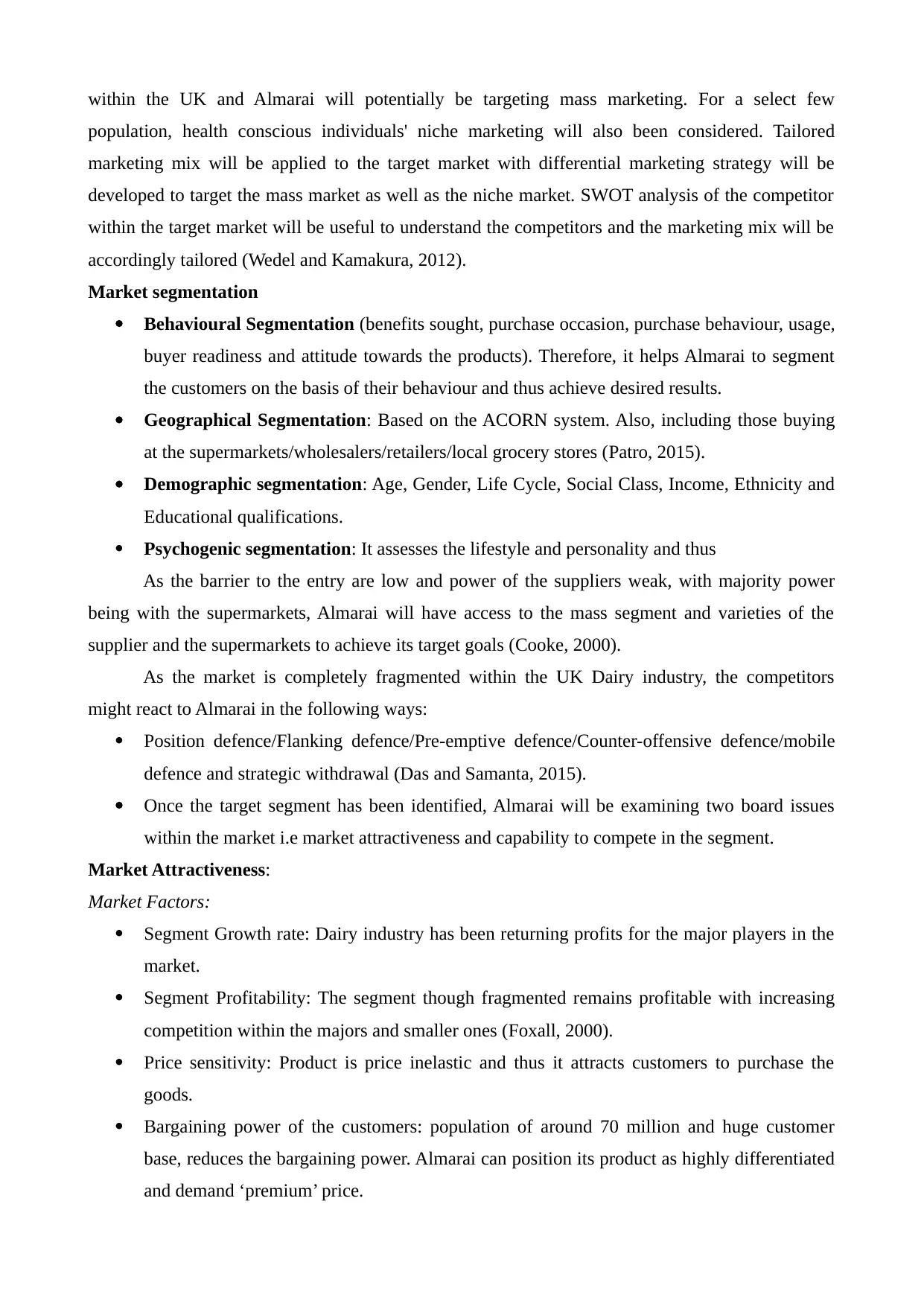
within the UK and Almarai will potentially be targeting mass marketing. For a select few
population, health conscious individuals' niche marketing will also been considered. Tailored
marketing mix will be applied to the target market with differential marketing strategy will be
developed to target the mass market as well as the niche market. SWOT analysis of the competitor
within the target market will be useful to understand the competitors and the marketing mix will be
accordingly tailored (Wedel and Kamakura, 2012).
Market segmentation
Behavioural Segmentation (benefits sought, purchase occasion, purchase behaviour, usage,
buyer readiness and attitude towards the products). Therefore, it helps Almarai to segment
the customers on the basis of their behaviour and thus achieve desired results.
Geographical Segmentation: Based on the ACORN system. Also, including those buying
at the supermarkets/wholesalers/retailers/local grocery stores (Patro, 2015).
Demographic segmentation: Age, Gender, Life Cycle, Social Class, Income, Ethnicity and
Educational qualifications.
Psychogenic segmentation: It assesses the lifestyle and personality and thus
As the barrier to the entry are low and power of the suppliers weak, with majority power
being with the supermarkets, Almarai will have access to the mass segment and varieties of the
supplier and the supermarkets to achieve its target goals (Cooke, 2000).
As the market is completely fragmented within the UK Dairy industry, the competitors
might react to Almarai in the following ways:
Position defence/Flanking defence/Pre-emptive defence/Counter-offensive defence/mobile
defence and strategic withdrawal (Das and Samanta, 2015).
Once the target segment has been identified, Almarai will be examining two board issues
within the market i.e market attractiveness and capability to compete in the segment.
Market Attractiveness:
Market Factors:
Segment Growth rate: Dairy industry has been returning profits for the major players in the
market.
Segment Profitability: The segment though fragmented remains profitable with increasing
competition within the majors and smaller ones (Foxall, 2000).
Price sensitivity: Product is price inelastic and thus it attracts customers to purchase the
goods.
Bargaining power of the customers: population of around 70 million and huge customer
base, reduces the bargaining power. Almarai can position its product as highly differentiated
and demand ‘premium’ price.
population, health conscious individuals' niche marketing will also been considered. Tailored
marketing mix will be applied to the target market with differential marketing strategy will be
developed to target the mass market as well as the niche market. SWOT analysis of the competitor
within the target market will be useful to understand the competitors and the marketing mix will be
accordingly tailored (Wedel and Kamakura, 2012).
Market segmentation
Behavioural Segmentation (benefits sought, purchase occasion, purchase behaviour, usage,
buyer readiness and attitude towards the products). Therefore, it helps Almarai to segment
the customers on the basis of their behaviour and thus achieve desired results.
Geographical Segmentation: Based on the ACORN system. Also, including those buying
at the supermarkets/wholesalers/retailers/local grocery stores (Patro, 2015).
Demographic segmentation: Age, Gender, Life Cycle, Social Class, Income, Ethnicity and
Educational qualifications.
Psychogenic segmentation: It assesses the lifestyle and personality and thus
As the barrier to the entry are low and power of the suppliers weak, with majority power
being with the supermarkets, Almarai will have access to the mass segment and varieties of the
supplier and the supermarkets to achieve its target goals (Cooke, 2000).
As the market is completely fragmented within the UK Dairy industry, the competitors
might react to Almarai in the following ways:
Position defence/Flanking defence/Pre-emptive defence/Counter-offensive defence/mobile
defence and strategic withdrawal (Das and Samanta, 2015).
Once the target segment has been identified, Almarai will be examining two board issues
within the market i.e market attractiveness and capability to compete in the segment.
Market Attractiveness:
Market Factors:
Segment Growth rate: Dairy industry has been returning profits for the major players in the
market.
Segment Profitability: The segment though fragmented remains profitable with increasing
competition within the majors and smaller ones (Foxall, 2000).
Price sensitivity: Product is price inelastic and thus it attracts customers to purchase the
goods.
Bargaining power of the customers: population of around 70 million and huge customer
base, reduces the bargaining power. Almarai can position its product as highly differentiated
and demand ‘premium’ price.
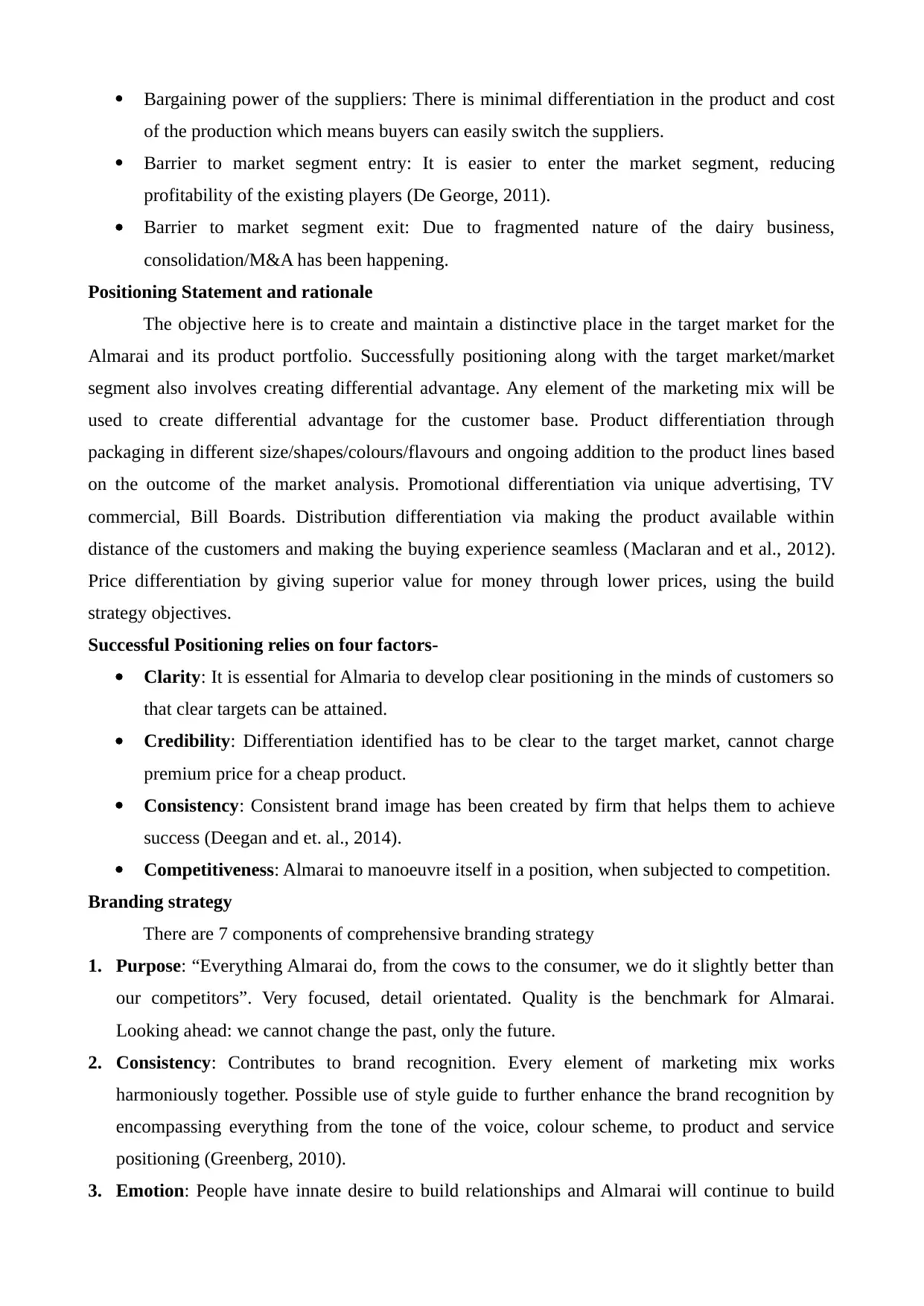
Bargaining power of the suppliers: There is minimal differentiation in the product and cost
of the production which means buyers can easily switch the suppliers.
Barrier to market segment entry: It is easier to enter the market segment, reducing
profitability of the existing players (De George, 2011).
Barrier to market segment exit: Due to fragmented nature of the dairy business,
consolidation/M&A has been happening.
Positioning Statement and rationale
The objective here is to create and maintain a distinctive place in the target market for the
Almarai and its product portfolio. Successfully positioning along with the target market/market
segment also involves creating differential advantage. Any element of the marketing mix will be
used to create differential advantage for the customer base. Product differentiation through
packaging in different size/shapes/colours/flavours and ongoing addition to the product lines based
on the outcome of the market analysis. Promotional differentiation via unique advertising, TV
commercial, Bill Boards. Distribution differentiation via making the product available within
distance of the customers and making the buying experience seamless (Maclaran and et al., 2012).
Price differentiation by giving superior value for money through lower prices, using the build
strategy objectives.
Successful Positioning relies on four factors-
Clarity: It is essential for Almaria to develop clear positioning in the minds of customers so
that clear targets can be attained.
Credibility: Differentiation identified has to be clear to the target market, cannot charge
premium price for a cheap product.
Consistency: Consistent brand image has been created by firm that helps them to achieve
success (Deegan and et. al., 2014).
Competitiveness: Almarai to manoeuvre itself in a position, when subjected to competition.
Branding strategy
There are 7 components of comprehensive branding strategy
1. Purpose: “Everything Almarai do, from the cows to the consumer, we do it slightly better than
our competitors”. Very focused, detail orientated. Quality is the benchmark for Almarai.
Looking ahead: we cannot change the past, only the future.
2. Consistency: Contributes to brand recognition. Every element of marketing mix works
harmoniously together. Possible use of style guide to further enhance the brand recognition by
encompassing everything from the tone of the voice, colour scheme, to product and service
positioning (Greenberg, 2010).
3. Emotion: People have innate desire to build relationships and Almarai will continue to build
of the production which means buyers can easily switch the suppliers.
Barrier to market segment entry: It is easier to enter the market segment, reducing
profitability of the existing players (De George, 2011).
Barrier to market segment exit: Due to fragmented nature of the dairy business,
consolidation/M&A has been happening.
Positioning Statement and rationale
The objective here is to create and maintain a distinctive place in the target market for the
Almarai and its product portfolio. Successfully positioning along with the target market/market
segment also involves creating differential advantage. Any element of the marketing mix will be
used to create differential advantage for the customer base. Product differentiation through
packaging in different size/shapes/colours/flavours and ongoing addition to the product lines based
on the outcome of the market analysis. Promotional differentiation via unique advertising, TV
commercial, Bill Boards. Distribution differentiation via making the product available within
distance of the customers and making the buying experience seamless (Maclaran and et al., 2012).
Price differentiation by giving superior value for money through lower prices, using the build
strategy objectives.
Successful Positioning relies on four factors-
Clarity: It is essential for Almaria to develop clear positioning in the minds of customers so
that clear targets can be attained.
Credibility: Differentiation identified has to be clear to the target market, cannot charge
premium price for a cheap product.
Consistency: Consistent brand image has been created by firm that helps them to achieve
success (Deegan and et. al., 2014).
Competitiveness: Almarai to manoeuvre itself in a position, when subjected to competition.
Branding strategy
There are 7 components of comprehensive branding strategy
1. Purpose: “Everything Almarai do, from the cows to the consumer, we do it slightly better than
our competitors”. Very focused, detail orientated. Quality is the benchmark for Almarai.
Looking ahead: we cannot change the past, only the future.
2. Consistency: Contributes to brand recognition. Every element of marketing mix works
harmoniously together. Possible use of style guide to further enhance the brand recognition by
encompassing everything from the tone of the voice, colour scheme, to product and service
positioning (Greenberg, 2010).
3. Emotion: People have innate desire to build relationships and Almarai will continue to build
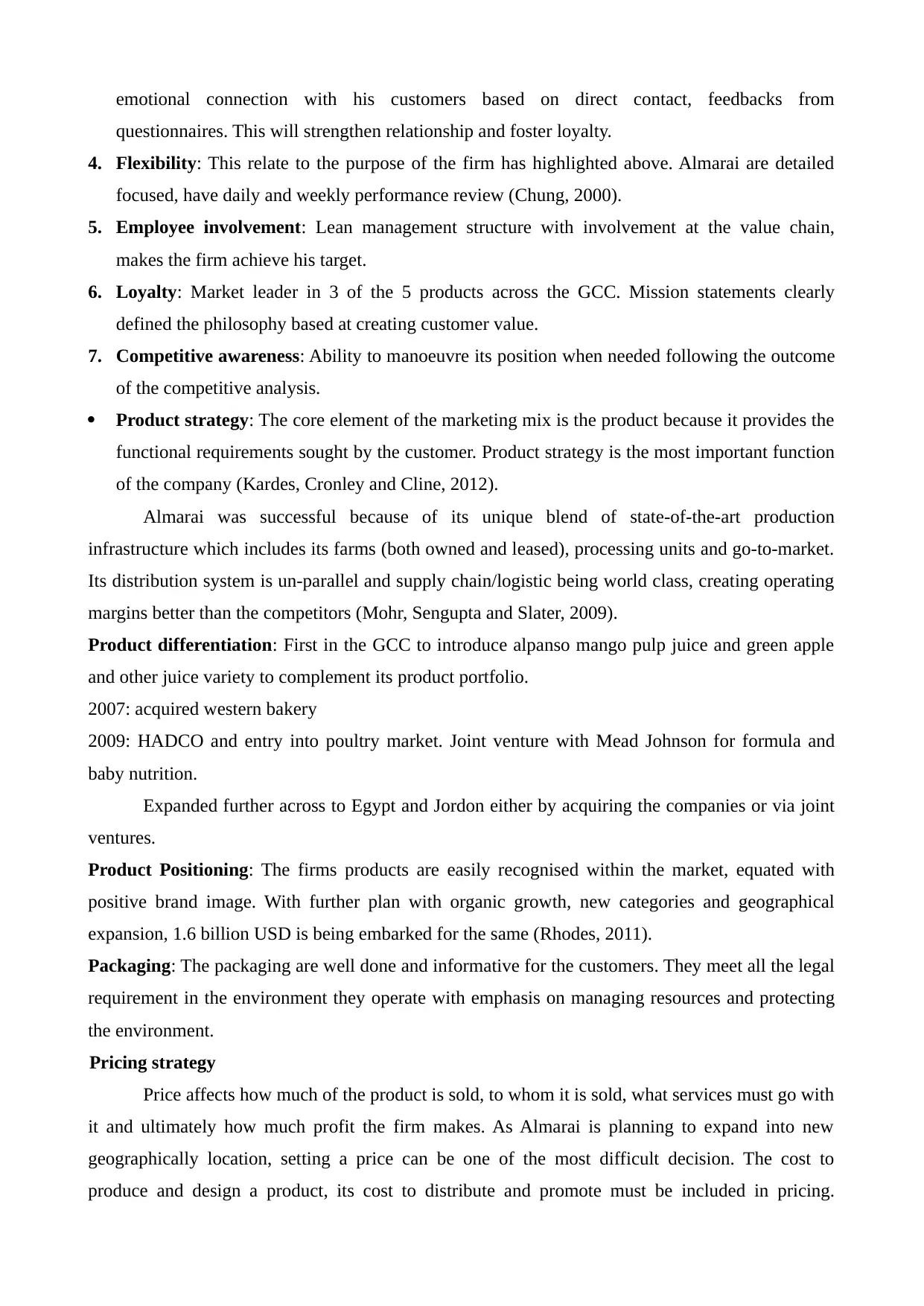
emotional connection with his customers based on direct contact, feedbacks from
questionnaires. This will strengthen relationship and foster loyalty.
4. Flexibility: This relate to the purpose of the firm has highlighted above. Almarai are detailed
focused, have daily and weekly performance review (Chung, 2000).
5. Employee involvement: Lean management structure with involvement at the value chain,
makes the firm achieve his target.
6. Loyalty: Market leader in 3 of the 5 products across the GCC. Mission statements clearly
defined the philosophy based at creating customer value.
7. Competitive awareness: Ability to manoeuvre its position when needed following the outcome
of the competitive analysis.
Product strategy: The core element of the marketing mix is the product because it provides the
functional requirements sought by the customer. Product strategy is the most important function
of the company (Kardes, Cronley and Cline, 2012).
Almarai was successful because of its unique blend of state-of-the-art production
infrastructure which includes its farms (both owned and leased), processing units and go-to-market.
Its distribution system is un-parallel and supply chain/logistic being world class, creating operating
margins better than the competitors (Mohr, Sengupta and Slater, 2009).
Product differentiation: First in the GCC to introduce alpanso mango pulp juice and green apple
and other juice variety to complement its product portfolio.
2007: acquired western bakery
2009: HADCO and entry into poultry market. Joint venture with Mead Johnson for formula and
baby nutrition.
Expanded further across to Egypt and Jordon either by acquiring the companies or via joint
ventures.
Product Positioning: The firms products are easily recognised within the market, equated with
positive brand image. With further plan with organic growth, new categories and geographical
expansion, 1.6 billion USD is being embarked for the same (Rhodes, 2011).
Packaging: The packaging are well done and informative for the customers. They meet all the legal
requirement in the environment they operate with emphasis on managing resources and protecting
the environment.
Pricing strategy
Price affects how much of the product is sold, to whom it is sold, what services must go with
it and ultimately how much profit the firm makes. As Almarai is planning to expand into new
geographically location, setting a price can be one of the most difficult decision. The cost to
produce and design a product, its cost to distribute and promote must be included in pricing.
questionnaires. This will strengthen relationship and foster loyalty.
4. Flexibility: This relate to the purpose of the firm has highlighted above. Almarai are detailed
focused, have daily and weekly performance review (Chung, 2000).
5. Employee involvement: Lean management structure with involvement at the value chain,
makes the firm achieve his target.
6. Loyalty: Market leader in 3 of the 5 products across the GCC. Mission statements clearly
defined the philosophy based at creating customer value.
7. Competitive awareness: Ability to manoeuvre its position when needed following the outcome
of the competitive analysis.
Product strategy: The core element of the marketing mix is the product because it provides the
functional requirements sought by the customer. Product strategy is the most important function
of the company (Kardes, Cronley and Cline, 2012).
Almarai was successful because of its unique blend of state-of-the-art production
infrastructure which includes its farms (both owned and leased), processing units and go-to-market.
Its distribution system is un-parallel and supply chain/logistic being world class, creating operating
margins better than the competitors (Mohr, Sengupta and Slater, 2009).
Product differentiation: First in the GCC to introduce alpanso mango pulp juice and green apple
and other juice variety to complement its product portfolio.
2007: acquired western bakery
2009: HADCO and entry into poultry market. Joint venture with Mead Johnson for formula and
baby nutrition.
Expanded further across to Egypt and Jordon either by acquiring the companies or via joint
ventures.
Product Positioning: The firms products are easily recognised within the market, equated with
positive brand image. With further plan with organic growth, new categories and geographical
expansion, 1.6 billion USD is being embarked for the same (Rhodes, 2011).
Packaging: The packaging are well done and informative for the customers. They meet all the legal
requirement in the environment they operate with emphasis on managing resources and protecting
the environment.
Pricing strategy
Price affects how much of the product is sold, to whom it is sold, what services must go with
it and ultimately how much profit the firm makes. As Almarai is planning to expand into new
geographically location, setting a price can be one of the most difficult decision. The cost to
produce and design a product, its cost to distribute and promote must be included in pricing.
Secure Best Marks with AI Grader
Need help grading? Try our AI Grader for instant feedback on your assignments.
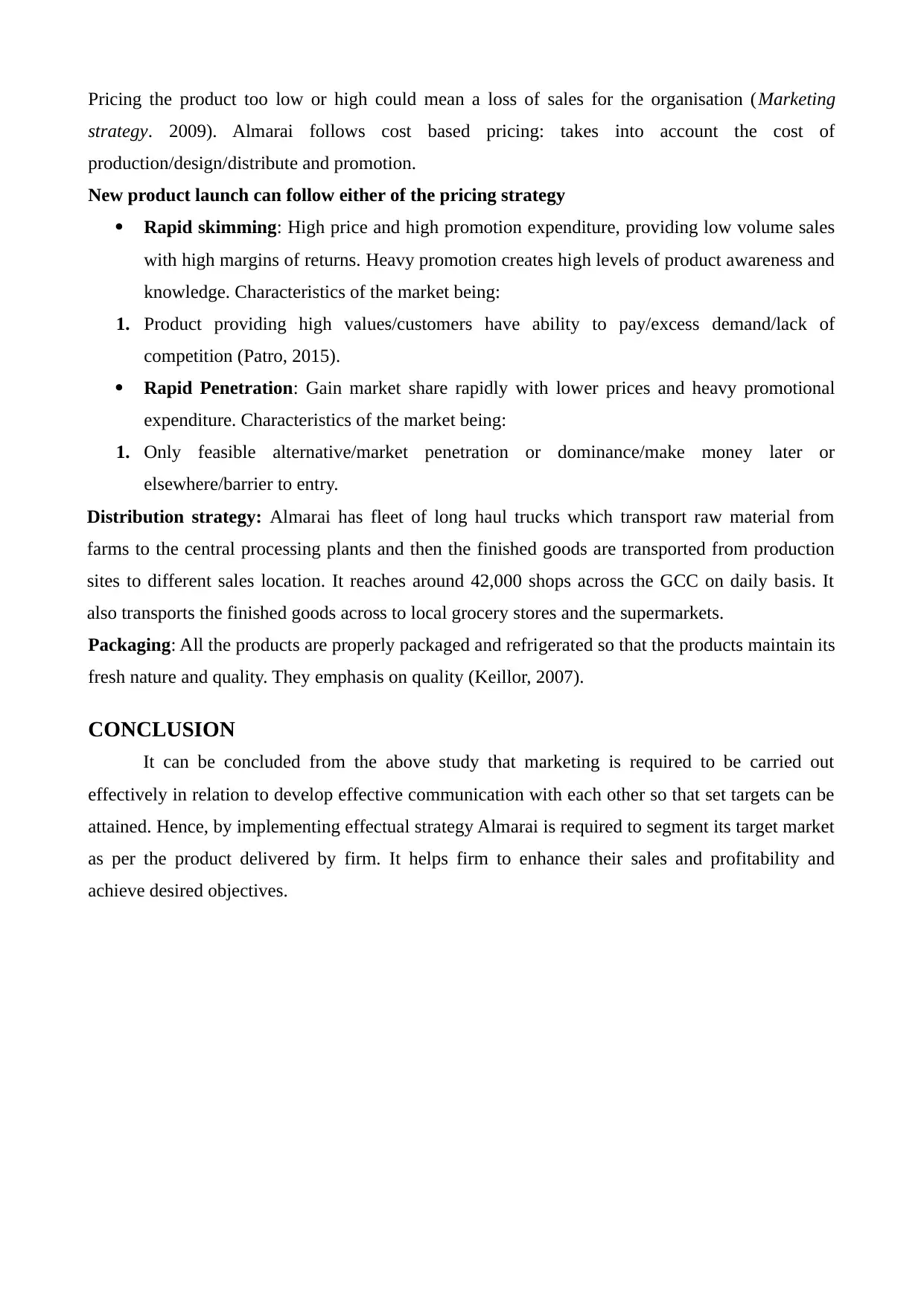
Pricing the product too low or high could mean a loss of sales for the organisation (Marketing
strategy. 2009). Almarai follows cost based pricing: takes into account the cost of
production/design/distribute and promotion.
New product launch can follow either of the pricing strategy
Rapid skimming: High price and high promotion expenditure, providing low volume sales
with high margins of returns. Heavy promotion creates high levels of product awareness and
knowledge. Characteristics of the market being:
1. Product providing high values/customers have ability to pay/excess demand/lack of
competition (Patro, 2015).
Rapid Penetration: Gain market share rapidly with lower prices and heavy promotional
expenditure. Characteristics of the market being:
1. Only feasible alternative/market penetration or dominance/make money later or
elsewhere/barrier to entry.
Distribution strategy: Almarai has fleet of long haul trucks which transport raw material from
farms to the central processing plants and then the finished goods are transported from production
sites to different sales location. It reaches around 42,000 shops across the GCC on daily basis. It
also transports the finished goods across to local grocery stores and the supermarkets.
Packaging: All the products are properly packaged and refrigerated so that the products maintain its
fresh nature and quality. They emphasis on quality (Keillor, 2007).
CONCLUSION
It can be concluded from the above study that marketing is required to be carried out
effectively in relation to develop effective communication with each other so that set targets can be
attained. Hence, by implementing effectual strategy Almarai is required to segment its target market
as per the product delivered by firm. It helps firm to enhance their sales and profitability and
achieve desired objectives.
strategy. 2009). Almarai follows cost based pricing: takes into account the cost of
production/design/distribute and promotion.
New product launch can follow either of the pricing strategy
Rapid skimming: High price and high promotion expenditure, providing low volume sales
with high margins of returns. Heavy promotion creates high levels of product awareness and
knowledge. Characteristics of the market being:
1. Product providing high values/customers have ability to pay/excess demand/lack of
competition (Patro, 2015).
Rapid Penetration: Gain market share rapidly with lower prices and heavy promotional
expenditure. Characteristics of the market being:
1. Only feasible alternative/market penetration or dominance/make money later or
elsewhere/barrier to entry.
Distribution strategy: Almarai has fleet of long haul trucks which transport raw material from
farms to the central processing plants and then the finished goods are transported from production
sites to different sales location. It reaches around 42,000 shops across the GCC on daily basis. It
also transports the finished goods across to local grocery stores and the supermarkets.
Packaging: All the products are properly packaged and refrigerated so that the products maintain its
fresh nature and quality. They emphasis on quality (Keillor, 2007).
CONCLUSION
It can be concluded from the above study that marketing is required to be carried out
effectively in relation to develop effective communication with each other so that set targets can be
attained. Hence, by implementing effectual strategy Almarai is required to segment its target market
as per the product delivered by firm. It helps firm to enhance their sales and profitability and
achieve desired objectives.
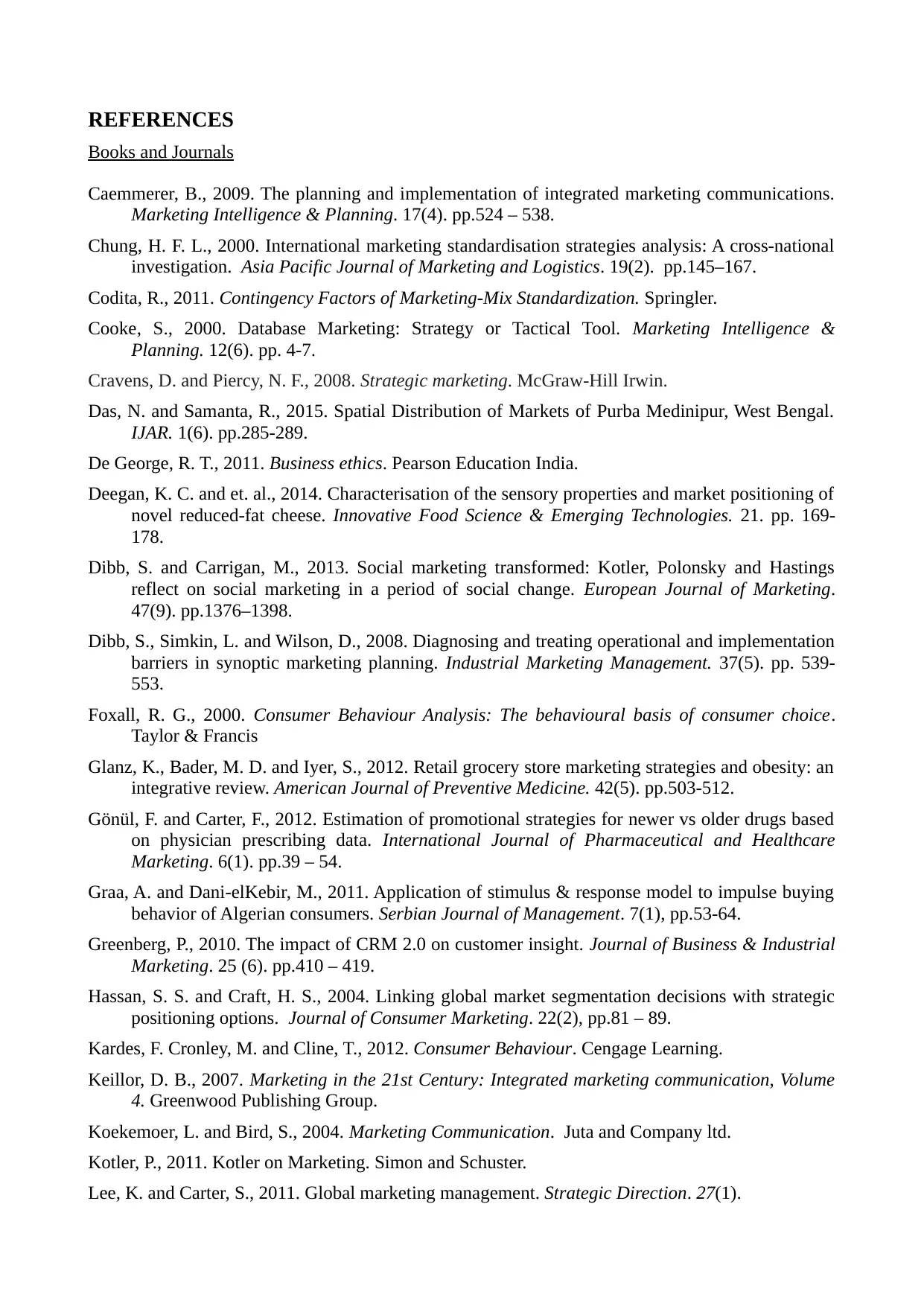
REFERENCES
Books and Journals
Caemmerer, B., 2009. The planning and implementation of integrated marketing communications.
Marketing Intelligence & Planning. 17(4). pp.524 – 538.
Chung, H. F. L., 2000. International marketing standardisation strategies analysis: A cross-national
investigation. Asia Pacific Journal of Marketing and Logistics. 19(2). pp.145–167.
Codita, R., 2011. Contingency Factors of Marketing-Mix Standardization. Springler.
Cooke, S., 2000. Database Marketing: Strategy or Tactical Tool. Marketing Intelligence &
Planning. 12(6). pp. 4-7.
Cravens, D. and Piercy, N. F., 2008. Strategic marketing. McGraw-Hill Irwin.
Das, N. and Samanta, R., 2015. Spatial Distribution of Markets of Purba Medinipur, West Bengal.
IJAR. 1(6). pp.285-289.
De George, R. T., 2011. Business ethics. Pearson Education India.
Deegan, K. C. and et. al., 2014. Characterisation of the sensory properties and market positioning of
novel reduced-fat cheese. Innovative Food Science & Emerging Technologies. 21. pp. 169-
178.
Dibb, S. and Carrigan, M., 2013. Social marketing transformed: Kotler, Polonsky and Hastings
reflect on social marketing in a period of social change. European Journal of Marketing.
47(9). pp.1376–1398.
Dibb, S., Simkin, L. and Wilson, D., 2008. Diagnosing and treating operational and implementation
barriers in synoptic marketing planning. Industrial Marketing Management. 37(5). pp. 539-
553.
Foxall, R. G., 2000. Consumer Behaviour Analysis: The behavioural basis of consumer choice.
Taylor & Francis
Glanz, K., Bader, M. D. and Iyer, S., 2012. Retail grocery store marketing strategies and obesity: an
integrative review. American Journal of Preventive Medicine. 42(5). pp.503-512.
Gönül, F. and Carter, F., 2012. Estimation of promotional strategies for newer vs older drugs based
on physician prescribing data. International Journal of Pharmaceutical and Healthcare
Marketing. 6(1). pp.39 – 54.
Graa, A. and Dani-elKebir, M., 2011. Application of stimulus & response model to impulse buying
behavior of Algerian consumers. Serbian Journal of Management. 7(1), pp.53-64.
Greenberg, P., 2010. The impact of CRM 2.0 on customer insight. Journal of Business & Industrial
Marketing. 25 (6). pp.410 – 419.
Hassan, S. S. and Craft, H. S., 2004. Linking global market segmentation decisions with strategic
positioning options. Journal of Consumer Marketing. 22(2), pp.81 – 89.
Kardes, F. Cronley, M. and Cline, T., 2012. Consumer Behaviour. Cengage Learning.
Keillor, D. B., 2007. Marketing in the 21st Century: Integrated marketing communication, Volume
4. Greenwood Publishing Group.
Koekemoer, L. and Bird, S., 2004. Marketing Communication. Juta and Company ltd.
Kotler, P., 2011. Kotler on Marketing. Simon and Schuster.
Lee, K. and Carter, S., 2011. Global marketing management. Strategic Direction. 27(1).
Books and Journals
Caemmerer, B., 2009. The planning and implementation of integrated marketing communications.
Marketing Intelligence & Planning. 17(4). pp.524 – 538.
Chung, H. F. L., 2000. International marketing standardisation strategies analysis: A cross-national
investigation. Asia Pacific Journal of Marketing and Logistics. 19(2). pp.145–167.
Codita, R., 2011. Contingency Factors of Marketing-Mix Standardization. Springler.
Cooke, S., 2000. Database Marketing: Strategy or Tactical Tool. Marketing Intelligence &
Planning. 12(6). pp. 4-7.
Cravens, D. and Piercy, N. F., 2008. Strategic marketing. McGraw-Hill Irwin.
Das, N. and Samanta, R., 2015. Spatial Distribution of Markets of Purba Medinipur, West Bengal.
IJAR. 1(6). pp.285-289.
De George, R. T., 2011. Business ethics. Pearson Education India.
Deegan, K. C. and et. al., 2014. Characterisation of the sensory properties and market positioning of
novel reduced-fat cheese. Innovative Food Science & Emerging Technologies. 21. pp. 169-
178.
Dibb, S. and Carrigan, M., 2013. Social marketing transformed: Kotler, Polonsky and Hastings
reflect on social marketing in a period of social change. European Journal of Marketing.
47(9). pp.1376–1398.
Dibb, S., Simkin, L. and Wilson, D., 2008. Diagnosing and treating operational and implementation
barriers in synoptic marketing planning. Industrial Marketing Management. 37(5). pp. 539-
553.
Foxall, R. G., 2000. Consumer Behaviour Analysis: The behavioural basis of consumer choice.
Taylor & Francis
Glanz, K., Bader, M. D. and Iyer, S., 2012. Retail grocery store marketing strategies and obesity: an
integrative review. American Journal of Preventive Medicine. 42(5). pp.503-512.
Gönül, F. and Carter, F., 2012. Estimation of promotional strategies for newer vs older drugs based
on physician prescribing data. International Journal of Pharmaceutical and Healthcare
Marketing. 6(1). pp.39 – 54.
Graa, A. and Dani-elKebir, M., 2011. Application of stimulus & response model to impulse buying
behavior of Algerian consumers. Serbian Journal of Management. 7(1), pp.53-64.
Greenberg, P., 2010. The impact of CRM 2.0 on customer insight. Journal of Business & Industrial
Marketing. 25 (6). pp.410 – 419.
Hassan, S. S. and Craft, H. S., 2004. Linking global market segmentation decisions with strategic
positioning options. Journal of Consumer Marketing. 22(2), pp.81 – 89.
Kardes, F. Cronley, M. and Cline, T., 2012. Consumer Behaviour. Cengage Learning.
Keillor, D. B., 2007. Marketing in the 21st Century: Integrated marketing communication, Volume
4. Greenwood Publishing Group.
Koekemoer, L. and Bird, S., 2004. Marketing Communication. Juta and Company ltd.
Kotler, P., 2011. Kotler on Marketing. Simon and Schuster.
Lee, K. and Carter, S., 2011. Global marketing management. Strategic Direction. 27(1).
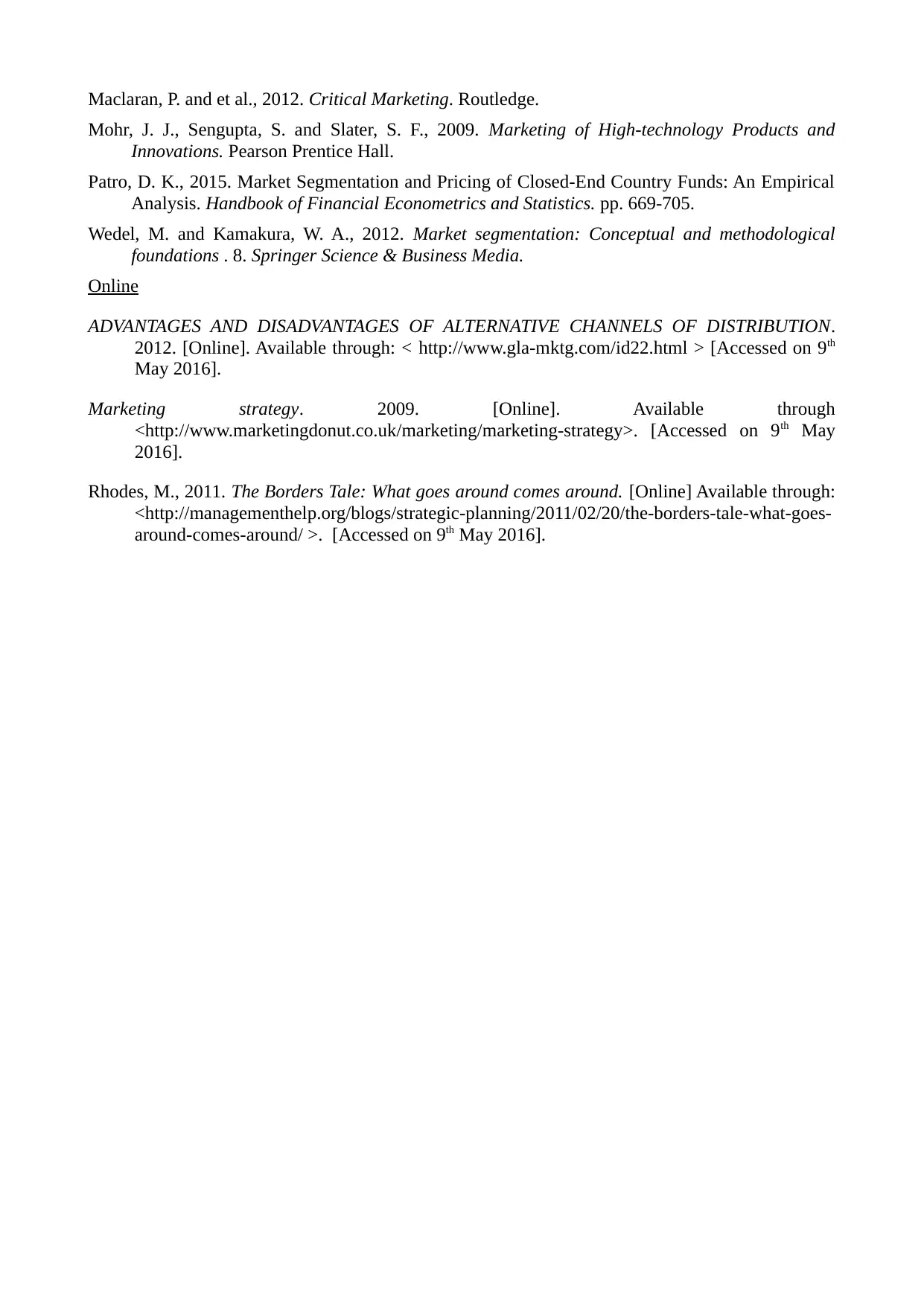
Maclaran, P. and et al., 2012. Critical Marketing. Routledge.
Mohr, J. J., Sengupta, S. and Slater, S. F., 2009. Marketing of High-technology Products and
Innovations. Pearson Prentice Hall.
Patro, D. K., 2015. Market Segmentation and Pricing of Closed-End Country Funds: An Empirical
Analysis. Handbook of Financial Econometrics and Statistics. pp. 669-705.
Wedel, M. and Kamakura, W. A., 2012. Market segmentation: Conceptual and methodological
foundations . 8. Springer Science & Business Media.
Online
ADVANTAGES AND DISADVANTAGES OF ALTERNATIVE CHANNELS OF DISTRIBUTION.
2012. [Online]. Available through: < http://www.gla-mktg.com/id22.html > [Accessed on 9th
May 2016].
Marketing strategy. 2009. [Online]. Available through
<http://www.marketingdonut.co.uk/marketing/marketing-strategy>. [Accessed on 9th May
2016].
Rhodes, M., 2011. The Borders Tale: What goes around comes around. [Online] Available through:
<http://managementhelp.org/blogs/strategic-planning/2011/02/20/the-borders-tale-what-goes-
around-comes-around/ >. [Accessed on 9th May 2016].
Mohr, J. J., Sengupta, S. and Slater, S. F., 2009. Marketing of High-technology Products and
Innovations. Pearson Prentice Hall.
Patro, D. K., 2015. Market Segmentation and Pricing of Closed-End Country Funds: An Empirical
Analysis. Handbook of Financial Econometrics and Statistics. pp. 669-705.
Wedel, M. and Kamakura, W. A., 2012. Market segmentation: Conceptual and methodological
foundations . 8. Springer Science & Business Media.
Online
ADVANTAGES AND DISADVANTAGES OF ALTERNATIVE CHANNELS OF DISTRIBUTION.
2012. [Online]. Available through: < http://www.gla-mktg.com/id22.html > [Accessed on 9th
May 2016].
Marketing strategy. 2009. [Online]. Available through
<http://www.marketingdonut.co.uk/marketing/marketing-strategy>. [Accessed on 9th May
2016].
Rhodes, M., 2011. The Borders Tale: What goes around comes around. [Online] Available through:
<http://managementhelp.org/blogs/strategic-planning/2011/02/20/the-borders-tale-what-goes-
around-comes-around/ >. [Accessed on 9th May 2016].
1 out of 19
Related Documents
Your All-in-One AI-Powered Toolkit for Academic Success.
+13062052269
info@desklib.com
Available 24*7 on WhatsApp / Email
![[object Object]](/_next/static/media/star-bottom.7253800d.svg)
Unlock your academic potential
© 2024 | Zucol Services PVT LTD | All rights reserved.




